Bordeaux 2021 from barrel : the reds
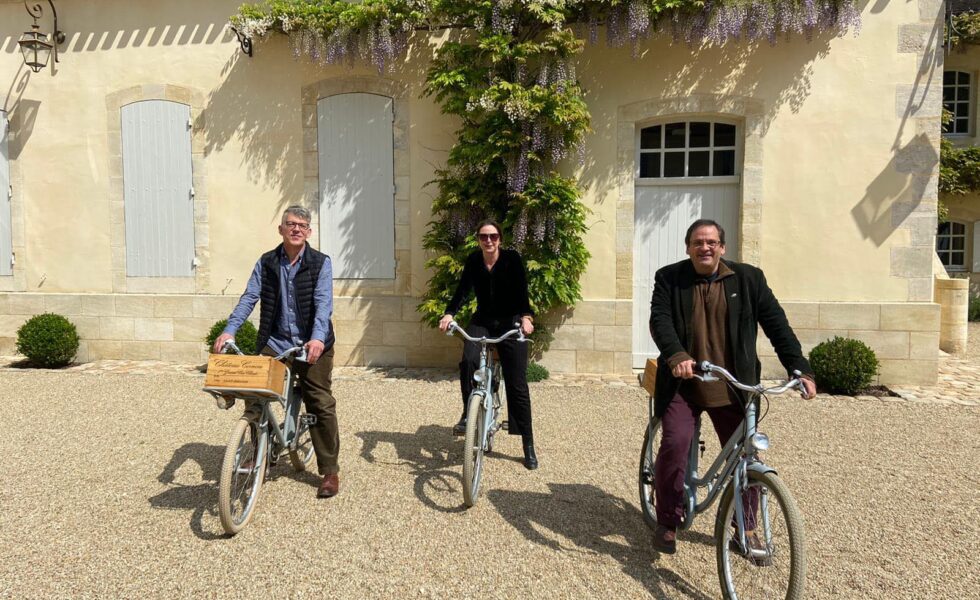
Bordeaux faces stalling futures campaign
By Panos Kakaviatos for wine-chronicles.com
27 May 2022
One of the last red barrel samples I tasted from Bordeaux’s 2021 vintage this year was on location at Château Gruaud Larose, in late May 2022, where CEO Nicolas Sinoquet explained how much hard work was needed to craft the best possible wine from the challenges of the vintage, over which you may have read in my earlier introduction.
Whatever we critics say about 2021, hats off to great efforts by estates committed to excellence, because we can write and assign a number, but that is but a trifle compared to months of stress from a stressful vintage.
As you follow new releases on Liv-ex, as well as comparative pricing analyses, several insiders told me in Bordeaux, that the futures campaign is stalling. With war in Europe, rising inflation and looming recession, who is buying an off vintage at prices (so far) too similar to 2020?
Having spoken to negociants, the sense is that Bordeaux would have done better to have said clearly that “Yes, we admit 2021 is an off vintage, but we propose a great discount, so try it for yourselves!”
Perhaps more buyers would be making orders? Instead, stocks are piling up, and many wines may well be sold only two years later at discount, if this trend continues.
As for the reds, sure, Bordeaux no longer makes bad wines, a common refrain from vintners in challenging vintages, but 2021 has a fair share of boring wines. So out of hundreds tasted from barrel, below my favorites, but even these would be better discounted by at least 20% over 2020, to better catch attention in a difficult market.
For tasting scores, ranges acknowledge sample variation, possible non-final blends, and it makes more sense to use a single score for a final bottled product for store shelves or delivery. I have been guilty of grade inflation in recent years, so ranges help insofar that the higher possible score reflects optimism. As usual, when in bold, I like especially. If red and bold, even more. And when underlined, too, approaching nirvana: Such wines tend to have the potential for 96 out of 100 points. An added asterisk*, up to (the rare) possible 97 🙂.
Right Bank: Côtes de Bordeaux and Fronsac, Pomerol (just below), Saint Emilion
Left Bank: Listrac/Médoc/Haut=Médoc/Moulis – Margaux – Saint Julien – Pauillac – Saint Estèphe – Graves/Pessac-Léognan
Pomerol
Château Beauregard – A deft touch at the UGCB tasting in Bordeaux. And even if one discerns a somewhat disjointed aspect between tannin and acidity from this blend of 70% Merlot and 30% Cabernet Franc, clocking in at 13% alcohol, it exudes ripeness and refinement. Experience not quite as positive at the Pomerol Séduction tasting. Look forward to assessing from bottle after having aged in 40% new oak. 91-93
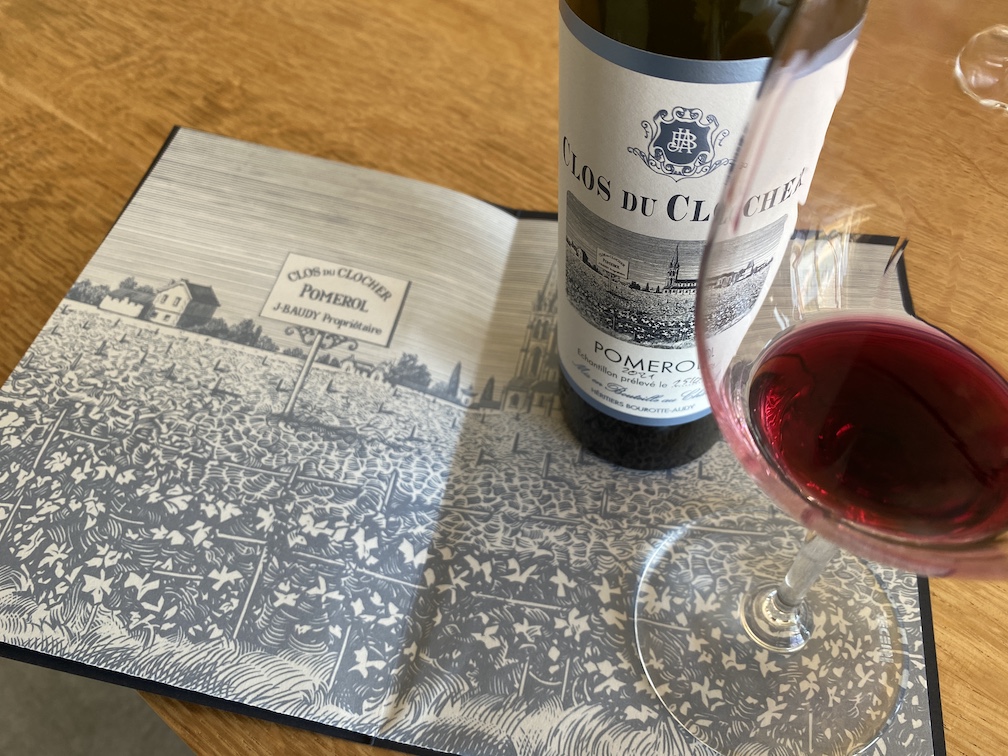
Château Bonalgue – Overall welcoming, albeit with chalky tannin, this somewhat leafy Merlot wine has good mid-palate density and includes 5% Cabernet Franc this year. Reflecting three types of Pomerol soil (sand, gravel and clay), the tannin seems however a bit austere. Mid palate juiciness reassures as the wine ages in 40% new oak, so let’s see how it tastes once bottled. 89-91
Château Bourgneuf – I love the fresh, “Atlantic Ocean” nose, with rather refined tannin: this blend of 85% Merlot and 15% Cabernet Franc stands out among Pomerol wines that I assessed at the Grand Cercle tasting, with finesse and refinement. Airy elegance on the finish. Tasted twice, consistent notes. Nice work! 92-94
Clos du Clocher – Tasted with Jane Anson, and we agreed that the estate transcends the vintage. With excellent mid-palate density, this blend of 70% Merlot and 30% Cabernet Franc, aging in 50% new oak, counts among top 2021 successes, with impressive “contained energy” power. If you want an inside purchase, go here. 93-95
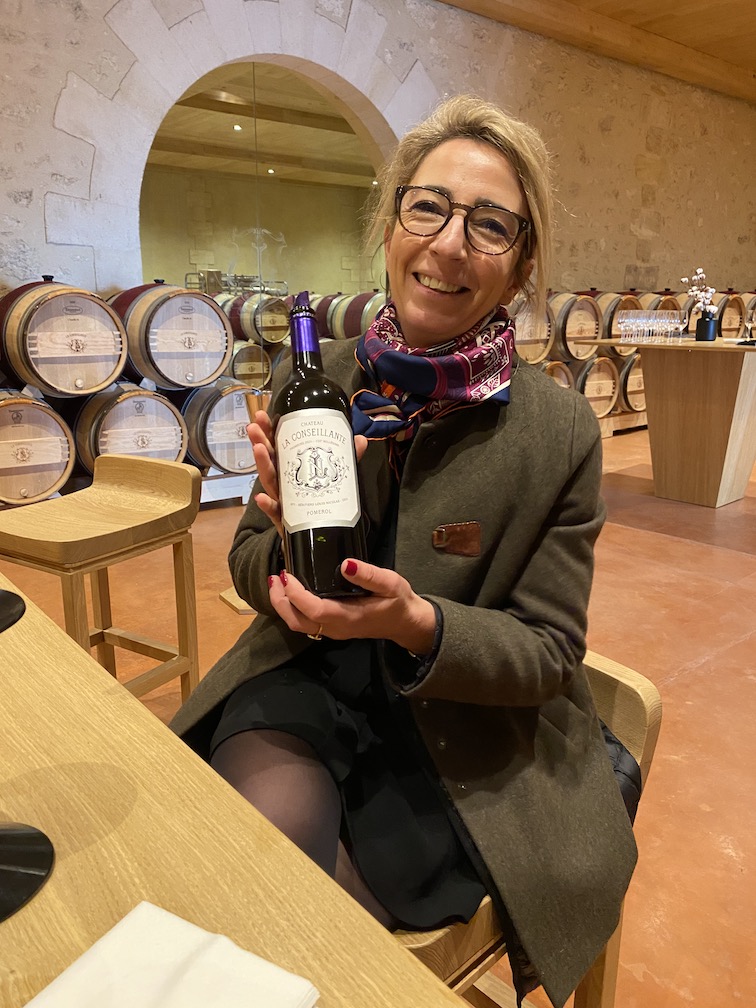
Marielle Cazaux of La Conseillante: reason to smile
Château La Conseillante – Lovely nose of violets, white flower and blueberry precedes a palate recalling the refined 2001, if not the opulence and density of 1998, 2005 or 2018. Another wine that transcends the vintage, this blend of 85% Merlot and 15% Cabernet Franc evokes juiciness and drinkability delivered with suave tannins in a subtle palate that should age nicely. Along with crispy, autumnal aspects comes palate creaminess difficult to find in 2021. With 13.3% alcohol and 3.6 pH, the wine is ageing in 70% new oak. Bravo! 94-96
Château Evangile – Although initially somewhat austere, this blend of 69% Merlot, 30% Cabernet Franc and 1% Cabernet Sauvignon reveals impressive density for the vintage, with black tea and cool blue fruit notes. While not as immediately exciting as La Conseillante, tasted just before, it could have more power, to assess down the road. Its first certified organic vintage proved a challenge. The rapid spread of mildew led to a crop of 20 hectoliters per hectare (half of neighbor La Conseillante). “It was like in 2018, but more virulent in 2021,” remarked technical director Juliette Couderc of the mildew. “By mid August, we were very worried, but thankfully the sun returned later, with temperatures above 25 degrees, even if there was no heat wave, either.” Ageing in 50% new oak, and 15% amphorae, the wine clocks in at 14% alcohol, with a 3.6 pH. 93-94
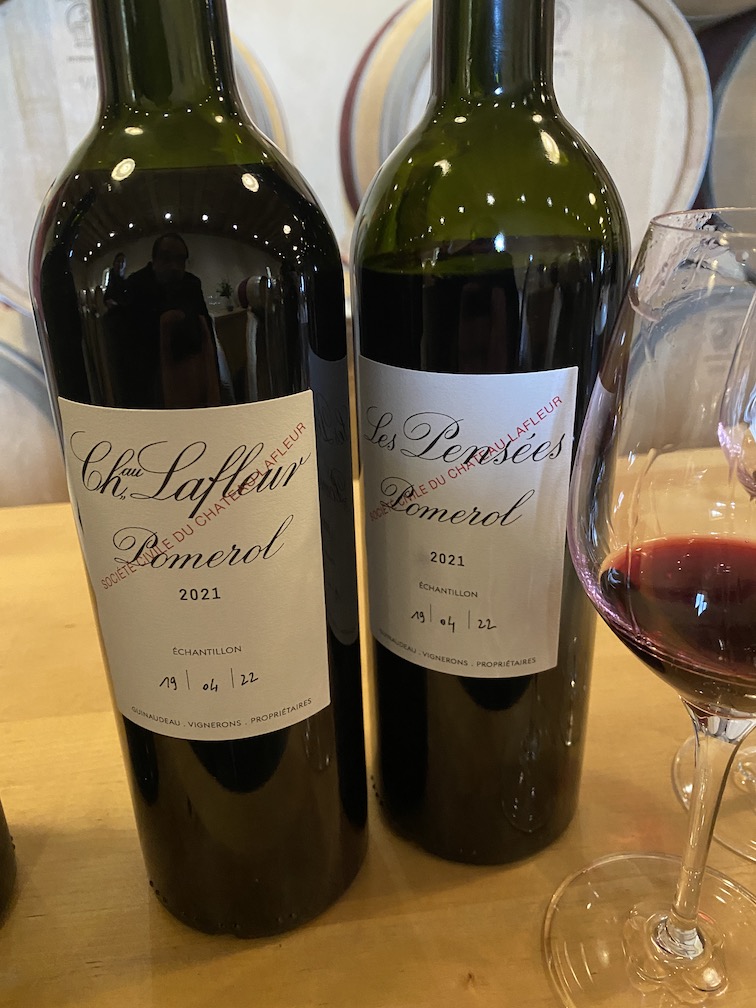
Why, of course!
Château Hosanna – The 25% Cabernet Franc lends much lift and freshness to the blend (the rest is Merlot), in a Hosanna that doesn’t match the glorious 2020, but impresses with excellent density for the vintage, black and red fruit ripeness and smooth tannin. A very fine Pomerol! Between 13 and 13.5% alcohol 93-95
Château Lafleur* – Candidate for wine of the vintage: sheer nobility in its cool, blueberry fruit, evoking expensive Havana cigars. I like the Merlot richness/sweetness to balance high-toned airy elegance from the Cabernet Franc (Bouchet). This blend of 52% Bouchet and 48% Merlot, is a high-wire act of excellence, with more ripe fruit than most other estates in 2021. No added sugar, clocking in at 13.5% alcohol. 95-97
Château La Fleur Pétrus – A fine success, overshadowing the other Pomerols of the JF Moueix portfolio, as this blend of 95% Merlot, 4% Cabernet Franc and 1% Petit Verdot starts with a brisk, fresh attack, leading to tannic finesse with notions of fine tea leaf and red fruit and a long finish. Well-balanced overall. 13% alcohol. 94-96
Château Latour à Pomerol – Just ripe enough plum and fine tannic power make this a solid entry for Pomerol indeed, and 100% Merlot to boot. Fine mid-palate density, even if the vintage character marks the wine: not as ripe and as bright as in previous vintages. 92-94
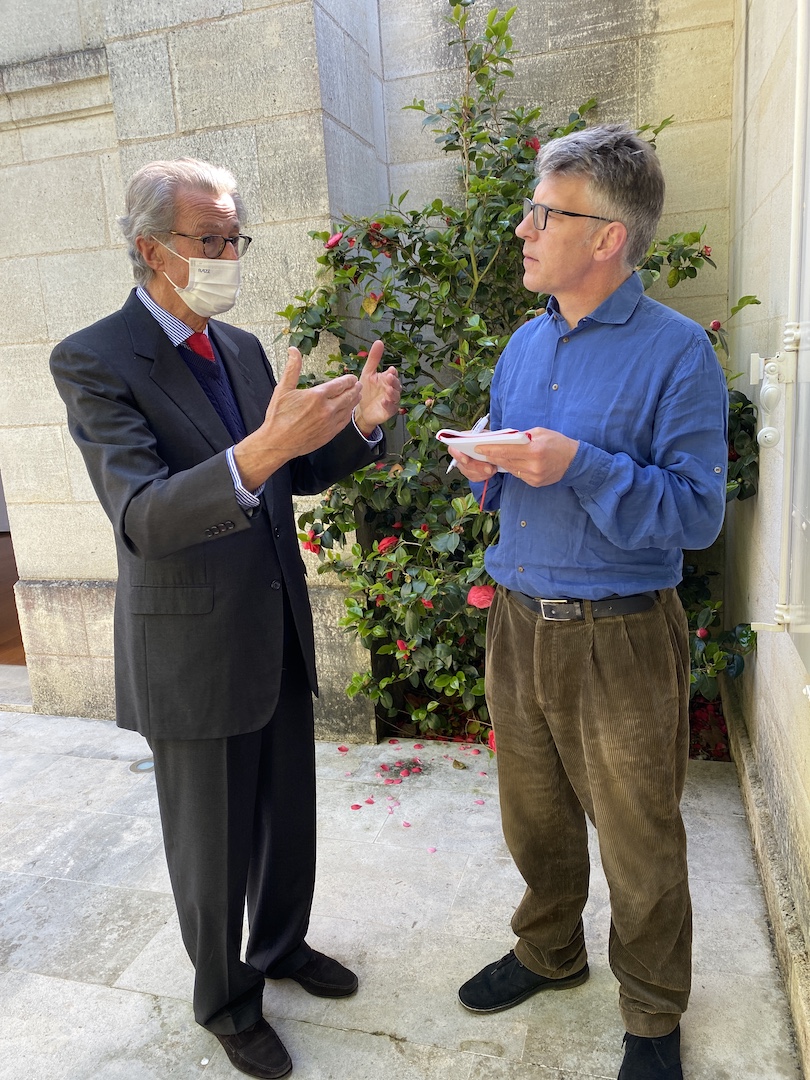
Fellow wine writer Adam Lechmere discussing 2021 vintage vagaries with Christian Moueix
Château La Grave – This blend of 96% Merlot and 4% Cabernet Franc, from grapes on vines grown on gravel and fine clays, performed very nicely: a pleasant attack, with brightness and fine density. 92-93
Château La Patache – Charming wine with smooth tannin in a blend of 85% Merlot and the rest Cabernet Franc. I like the fine iodine aspect and the impression left of judicious extraction. Aging in 30% new oak barrels. 91-93
Château La Pointe – Tasted three times and two out of three samples showed supple wine, not trying too hard to impress, rather smooth and agreeable. Indeed, this blend of 82% Merlot and 18% Cabernet Franc is a product of rigorous sorting that eliminated imperfect grapes and brought about a homogeneous crop as reflected in the wine. Picking as late as 13 October for optimal ripeness of the Cabernet Francs helped. In an e-mail, director Eric Monneret explained: “I’ve never over extracted in the last 10 years, and 2021 was not the vintage to change the rules,” he wrote. “Quite the contrary, it definitely was a vintage to fine-tune.” While not as impressive as the 2020, this is a fine effort indeed. 92-93
Les Pensées de Lafleur – With 59% Merlot and the rest Cabernet Franc, this wine seems fleshier than Château Lafleur, but lacks the same pristine, racy texture. I like the iodine freshness however and depending on the price, this could be a very good affair. 93-95
Petrus – With mid palate density and enough power, finesse and freshness to mirror its famous blue clay, this is fine Petrus. Aromas and flavors include spring flower, blackberry and plum, but in a lower key than usual, as the vintage required careful “piloting”, explained director Olivier Berrouet, who stressed the importance of a later-than-usual harvest in 2021 (from 30 September to 9 October) for this precocious terroir. The main issue was the “lack of summer sun”, drawing a contrast with the preceding vintage: Even if bud break had started at about the same time in both 2020 and 2021, the 2020 harvest took place three weeks earlier. Two factors “saved” 2021, Berrouet said. First, summer was at least “relatively dry” even if not sunny and, second, a “very nice September allowed grapes to get ripe”. “We do not have the same fleshiness or aromatic palette of 2020, but we made a worthy wine, meaning mid-palate density and length.” 94-95
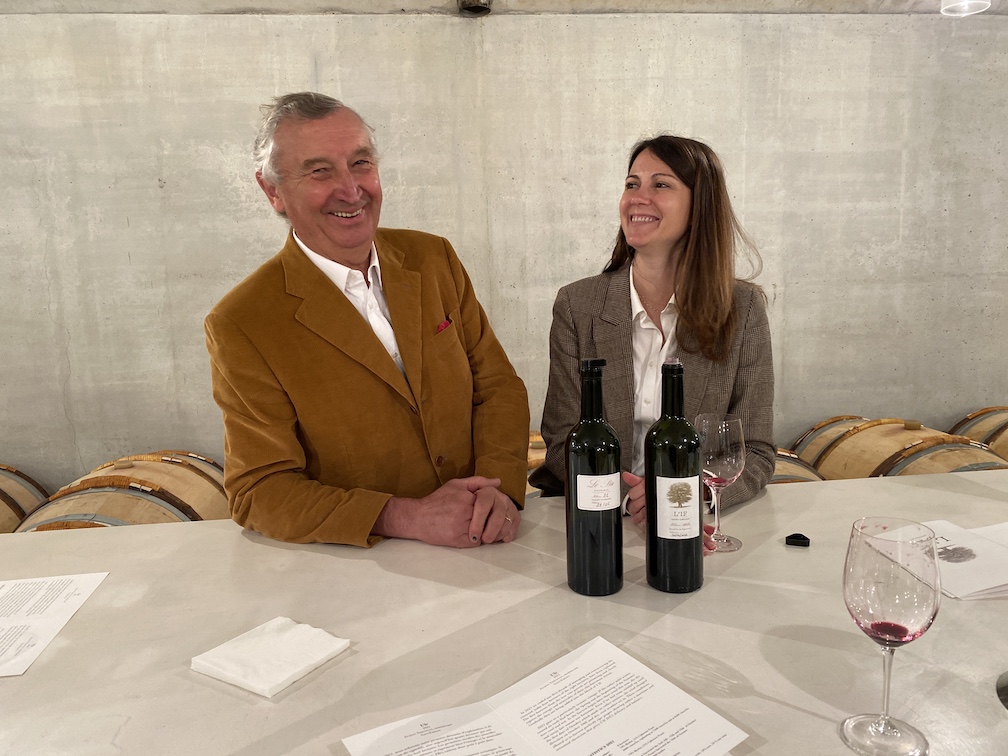
Arrived earlier this year from Château Petit Village: Diana Berrouet Garcia with Château Le Pin owner Jacques Thienpont
Château Le Pin – This estate strikes a delicate touch with subtle notions of ripe fruit, wet stone and floral aspects – as if done without effort, contradicting the difficulties of the vintage. Diana Berrouet Garcia had arrived at the beginning of the year from Petit Village, and having spoken to her many times about her philosophy, she admires the soft extraction approach of father-in-law Jean-Claude Berrouet, and it shows in this wine. I think that the wine could reach 96 if we see how it fares after barrel aging. Berrouet joins consulting winemaker Guillaume Thienpont. I don’t taste this wine as regularly as I would like to, but I feel that the barrel sample (100% Merlot) aging in 70% new oak, will only get better from bottle. Clocks in at just under 13.5% alcohol. 94-96
Château Rouget – This blend of 80% Merlot and the rest Cabernet Franc displays grip, as tasted at the UGCB in Bordeaux. This successful Pomerol with sweet fruit gives the sense that the it will stand up to the oak as it ages (with less new oak for this vintage, at 33%). The sample I tried at the Pomerol Séduction tasting not as impressive, so a larger scale. Let’s see how it tastes from bottle… 90-93+
Enclos Tourmaline – This 100% Merlot exudes excellent density. And the 100% new oak lends structure without being noticeable. I like the mid palate juiciness. Just a touch dry on finish, but that should be OK after bottling. Looking forward to that! 92-94
Château Trotanoy – By the time you finish tasting, the power of this wine – its hallmark – is evident, although with some tannic austerity. There is something “aloof” in its delivery, even if the balance, density and “palate amplitude” delivers the goods. Not a great vintage, but as friend and author Jane Anson told me as we tasted it: “Trotanoy fans should buy it”, and I see why. 94-95
Château Vieux Maillet – Decent black and red fruit aromatics seduce and the agreeable richness in this blend of 80% Merlot, 15% Cabernet Franc and 5% Cabernet Sauvignon make the cut, aging in 30% new oak. Tasted twice with similar notes. 89-91
Château Vray Croix de Gay – An excellent performance here from the dream team Vincent Millet as director with Jean-Claude Berrouet consulting. I love the unusually smooth tannin refinement with mid-palate juiciness. While not the big style of, say, 2018, this fits the 2021 vintage style positively: elegance with mid-palate sap. 93-94
Château Angélus Premier Grand Cru Classé – This reminds me of the excellent 1996 vintage, which had at least 50% Cabernet Franc. But Angélus has never seen so much Cab Franc: a whopping 60% to 40% Merlot. With cooler and shorter fermentations for more careful extraction, needed in this vintage, the result is cool, crisp wine, with inky ripeness and fine integration of oak, with some Christmas spice notes. While not sublime, I recommend for the fascinating blend. Let’s see how it comes from bottle. Interesting to see new director Benjamin Laforet, who replaces Emmanuelle Fulchi, who had left in June last year – and surprised me at Vignobles K, where she now works for a great team. Laforet has been with Angélus since 2017, so is no stranger to the estate. 94-95
Château Balestard La Tonnelle Grand Cru Classé – This blend of 82% Merlot, 11% Cabernet Franc and 7% Cabernet Sauvignon has an oak-driven nose, with some charred notes, but laudable inner core energy and smooth tannin. A successful wine from Saint Emilion, when you consider the estate and if you like the style. Clocks in at 13.3% alcohol, aging in 50% new oak. 92-93
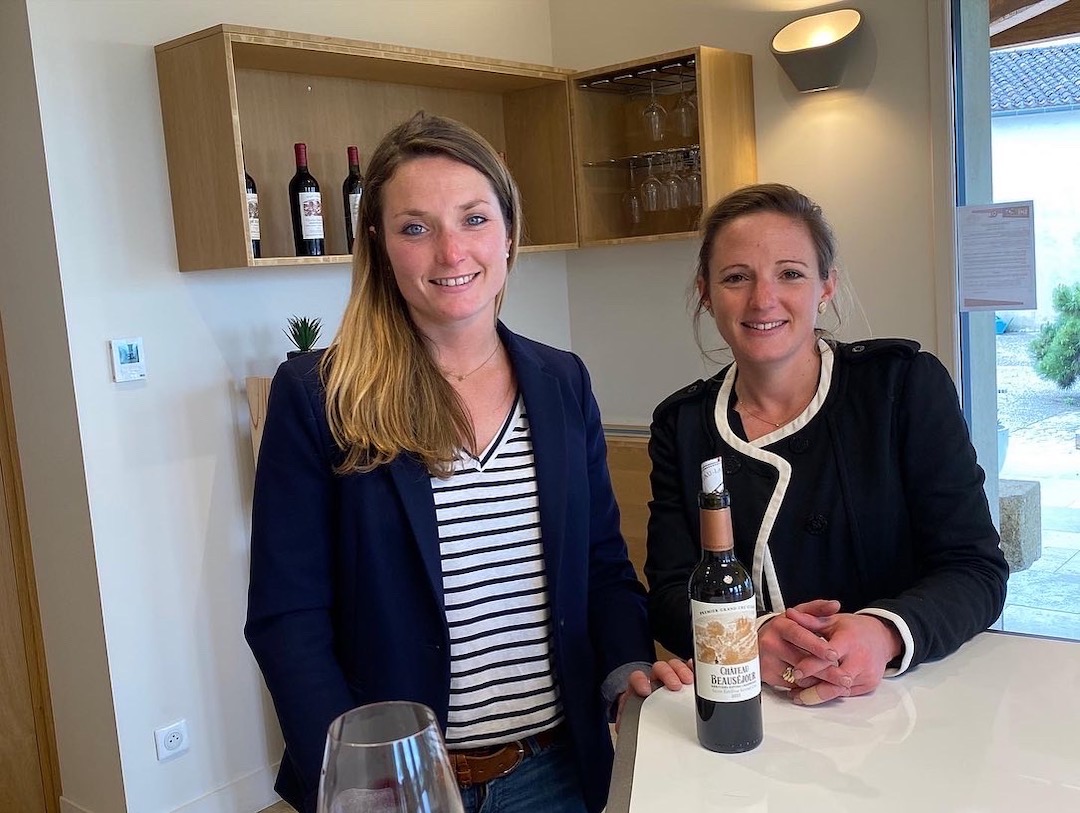
With Josephine Duffau-Lagarrosse and Camille Devillenaut at Château Beausejour Duffau-Lagarrosse
Château Beausejour Duffau Laggarrosse Premier Grand Cru Classé – Like neighbor Château Canon, the limestone freshness and purity and subtle floral and graphite notes excite the palate. As tasted with Josephine Duffau-Lagarrosse and co-technical director Camille Devillenaut, I get the impression of excellence from this blend of 73% Merlot and 27% Cabernet Franc, clocking in at 13.5% alcohol, aging in 58% new oak. 94-96
Château Bélair-Monange Premier Grand Cru Classé – This blend of 99% Merlot and 1% Cabernet Franc recalls the finesse of Château Canon, with a dollop of sweet, ripe fruit on the mid palate that impresses all the more because no added sugar was needed for balance. Although lacking the impressive arc/length of the aforementioned Canon, it comes across with finesse and ripeness. Exemplary illustration as to why 2021 doesn’t neatly favor one bank. 94-95
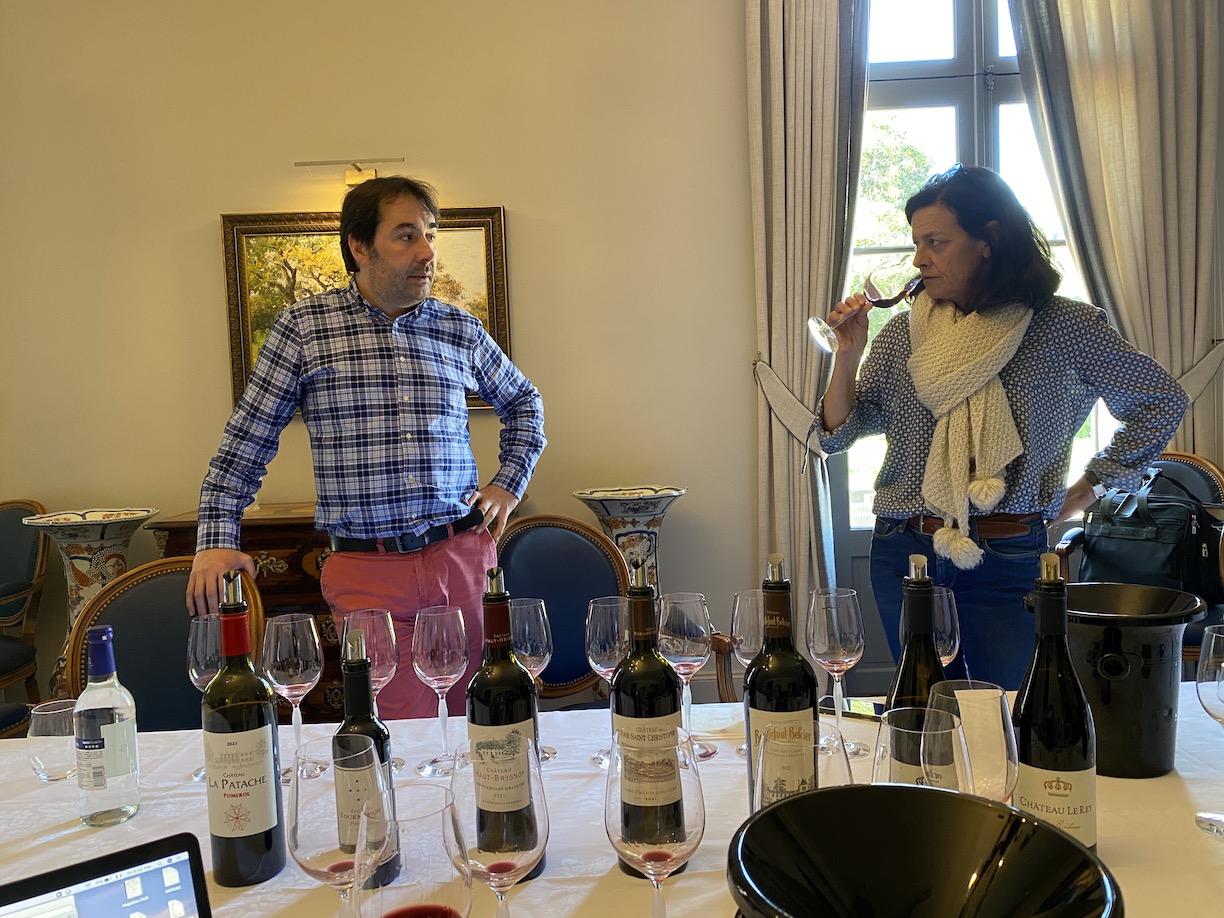
Assessing the wines of Vignobles K at Château Bellefont-Belcier with Jean-Christophe Meyrou and the recently arrived (from Angélus) Emmanuelle Fulchi
Château Bellefont-Belcier Grand Cru Classé – This blend of 70% Merlot, 25% Cabernet Franc and 5% Cabernet Sauvignon displays bright fruit and tobacco leaf, with smooth tannin and a long finish. You sense power and acidity for lift, body and freshness. Tasted after Tour Saint Christophe, a larger scale and superior palate contours and elegance. Hats off to Vignobles K for having me taste blind the 2019, 2020 and 2021. While I guessed each vintage correctly (not that hard), the 2021 measures well against the other two vintages, which is testimony to the hard work that the team led by Jean-Christophe Meyrou does each year to make the best possible wine. 92-94
Château Bellevue Grand Cru Classé – I like the refinement and density from this estate, a fine showing, as tasted once at the negociant Joanne. 100% Merlot. 92-93+
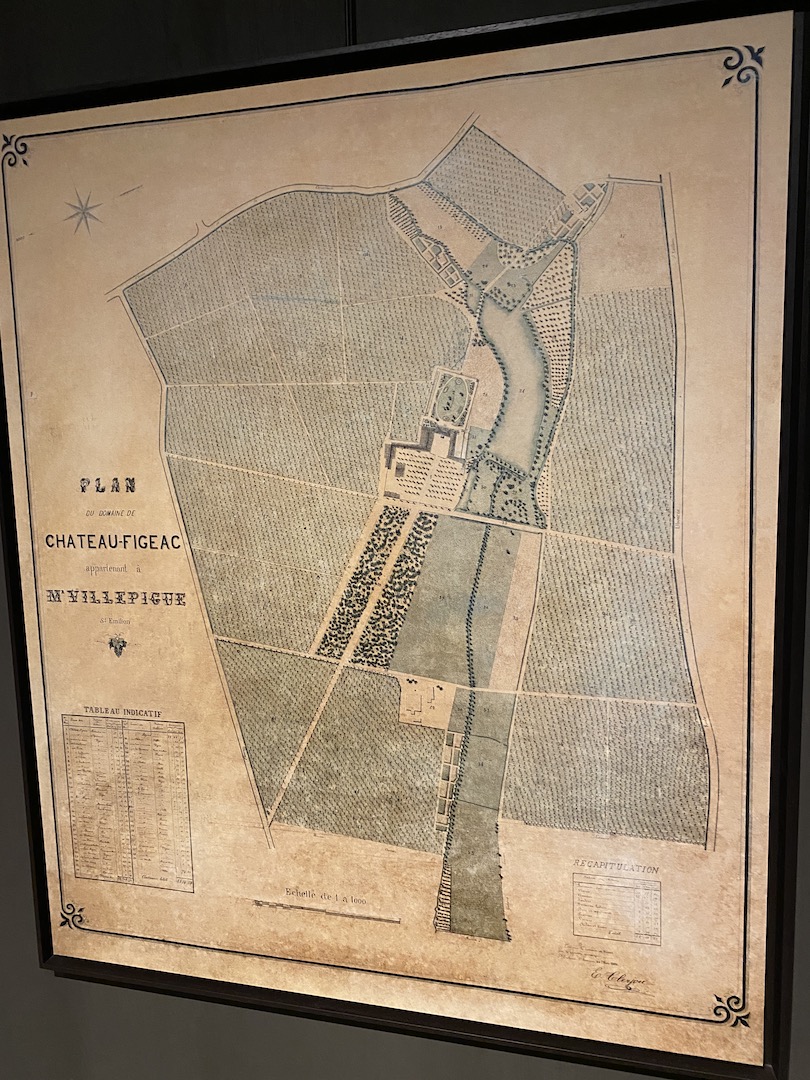
Great terroir, great wine: Château Figeac
Château Canon Premier Grand Cru Classé – Refined floral and wet stone notes, along with forest strawberry and raspberry from this blend of 71% Merlot and 29% Cabernet Franc. Tasted both at the UGCB in Bordeaux and at the estate: consistent notes. Interesting to compare with the 2020 vintage, which I had tasted the same week, and which displayed greater density, and came across more “effortlessly”… another indication of the superiority of 2020. But we have success in this challenging vintage. The palate is tight, yet toned, and even if the “follow through” on the palate does not quite meet aromatic promise, the estate crafted fine balance to benefit from barrel ageing. No bleeding of vats for concentration, albeit some chaptalisation. “The Merlot grapes were sometimes double the normal size,” explained director Nicolas Audebert, so adding sugar yielded better balance to the acidities. With very low pH at 3.37, the acidity would have accentuated the tannin too much, Audebert added. The result is refined wine, with 50% new oak well integrated. It is uncertain how many months the wine will age in the oak, but between 16 and 18 months. Very close to 97, but I am being a bit cautious here! 13.5% alcohol. 94-96+
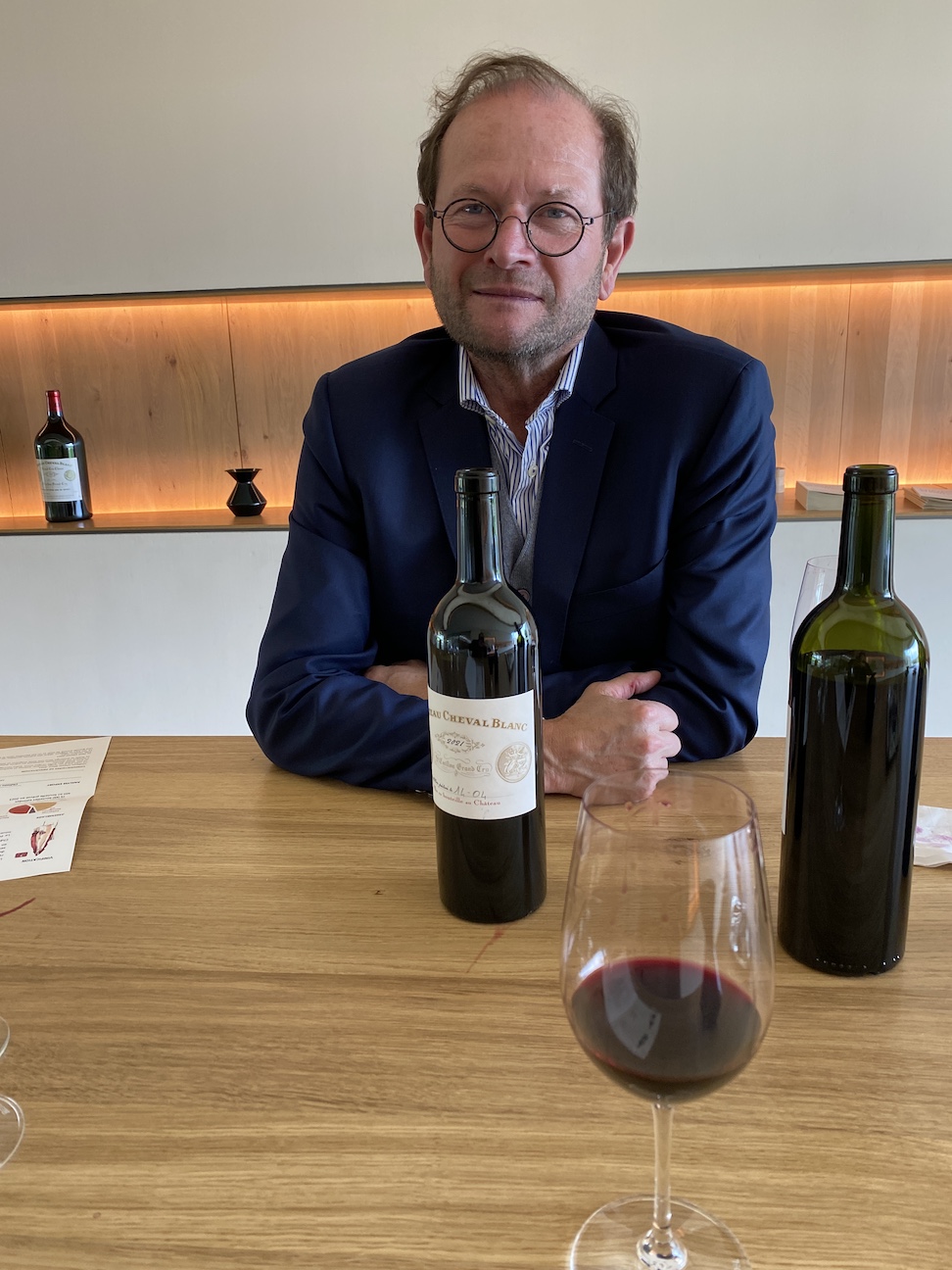
Pierre Lurton of Château Cheval Blanc
Château Cheval Blanc Premier Grand Cru Classé – Great terroirs can buffer the effects of a vintage, remarked Pierre Lurton as we tasted this blend of 52% Cabernet Franc, 43% Merlot and 5% Cabernet Sauvignon. Indeed, it exhibits charm and focus, with high-toned wild blackberry, floral and spice notes. There is less vivid juicy dark plum that one would expect from a more solar vintage of course. Lurton said that in 2021, the Merlots provide the “structure”, the Cabernet Franc “softness and finesse”, and the Cabernet Sauvignon acts like a pepper seasoning. The overall sensation is of racy breed, owing especially to the finesse of the Cabernet Franc, even if some tannic austerity is noted on the finish. 95-96+
Château Clos Fourtet Premier Grand Cru Classé – As with Canon, on the plateau, and a very low pH this vintage, at 3.45, but it lacks the wow factor of its neighbor. I like a hint of mint freshness from the 7% Cabernet Franc, but the Merlots drive the wine, with 90% of the blend (along with 3% of Cabernet Sauvignon), so you get pleasing notes of wet stone, blackberry, ripe plum and touches of chocolate. Tasted twice, albeit with a better performance at the UGCB than at the estate, where the sample seemed to exude less density and mid palate. Let’s see how it tastes from bottle. 93-95
Château Corbin Grand Cru Classé – One of the successes of the vintage, this blend of 90% Merlot and 10% Cabernet Franc exhibits beautiful fruit purity, reflecting ripeness from the warm, gravel/sand soils, with an area of blue clay lending density. The final blend, carried out in December, is reflected in this sample, ageing in 40% new oak – and the rest in glass tanks and concrete vats. The freshness and elegance are undeniable, as is the “drinkability”, even if it lacks the density of stronger vintages. In any case, a fine effort. 91-93
Château La Croizille Grand Cru – From an estate that is improving – with a chance at becoming Grand Cru Classé in the soon to be published rankings of Saint Emilion – this medium-bodied blend of 70% Merlot and 30% Cabernet Sauvignon conveys nuance with rather smooth tannin. Not “solar”, mind you, but with underlying seriousness and some cool blueberry charm, with fine integration of the 100% new oak for aging. Nice job! Tasted once at the Grand Cercle. 91-93
Château Figeac Premier Grand Cru Classé* – A candidate for wine of the vintage. Can you spell t-r-a-n-s-c-e-n-d? It has more juicy fruit than expected from the vintage, which director Frédéric Faye referred to as “of determination”. He and his team were determined to get optimal ripeness, and Figeac succeeds with flying colors. Rather predictably, the blend counts “the most Cabernet percentage ever,” Faye says, with 40% Cabernet Sauvignon, 31% Cabernet Franc and the rest Merlot, which had a tougher time. A decision taken to “ignore alarming weather forecasts for the weekend of 2 October” proved correct: two weeks of Indian summer ensued, which helped the Cabernets. While I would not compare the ripeness here to 2018, 2019 and 2020, the 2021 comes much closer than most, reflecting bright red and black fruit and remarkable tannic finesse rather rare for the vintage. Part of the success is due to the estate’s new winery, used for the first time for this vintage and through which the number of lots for blending was 40% higher than for the 2020 harvest, allowing greater precision after the painstaking harvest. Any fan of Figeac should get 2021 in their cellar. As ever, 100% new oak. And alcohol at 13% with a pH of 3.65. 95-97
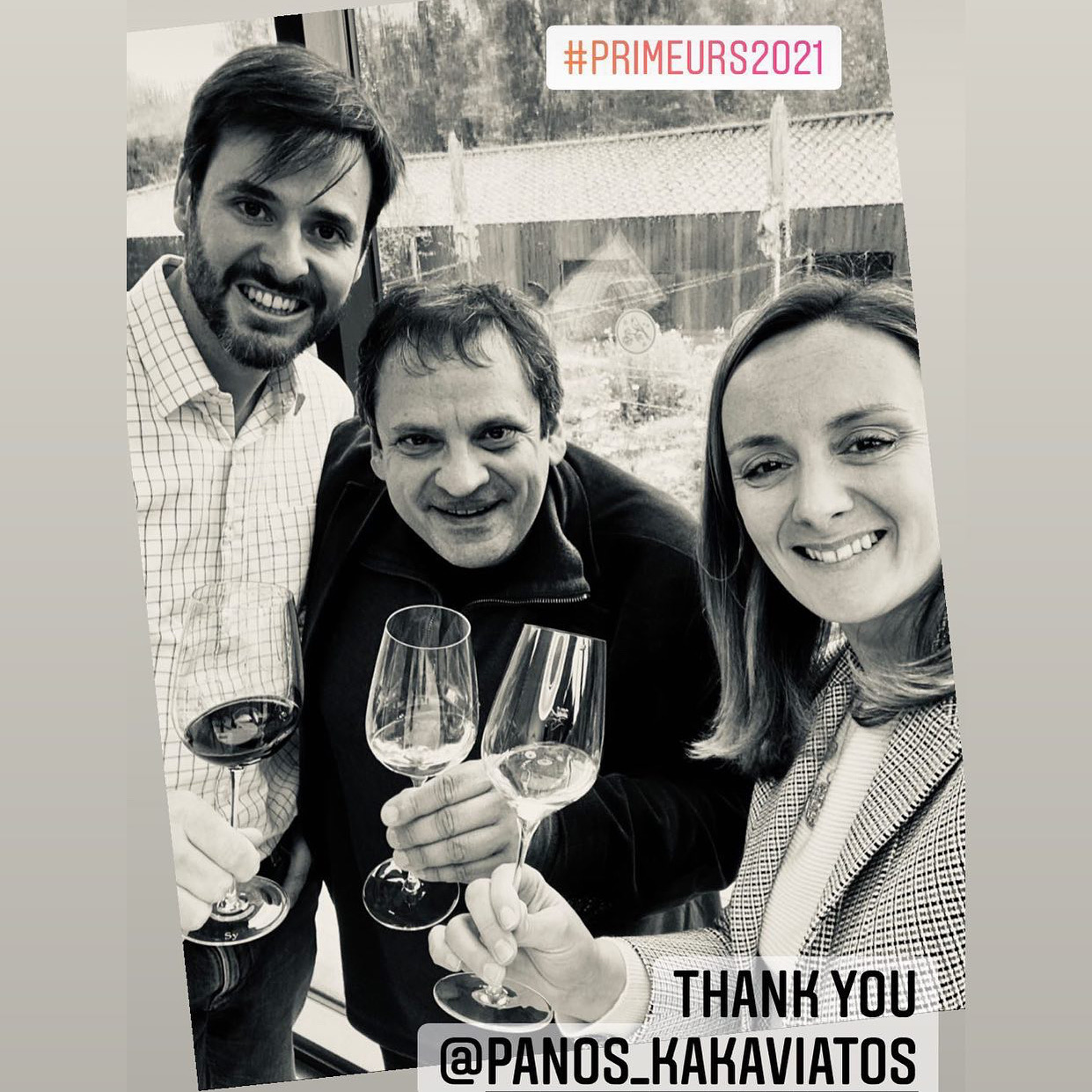
At Château La Fleur Cardinale
Château Fleur Cardinale Grand Cru Classé – Smooth tannins and refined, this blend of 60% Merlot, 30% Cabernet Franc and the rest Cabernet Sauvignon clocking in at 13.5% alcohol has ripe fruit and juicy finesse. 2021 marks the first year towards conversion to organic, aiming for 2024 certification. I feel like they could do with still less new oak, although the quotient dropped from 100% to 90% with the 2020 vintage. The painstaking attention paid to pair specific lots of wine to each barrel impresses; the blend will be done after barrel ageing. 92-94
Château Fonroque Grand Cru Classé – Tasted twice with conflicting results, but the better sample displayed a fine vinous aspect in this blend of 69% Merlot and 31% Cabernet Franc, yielding salinity and tannic refinement in the context of the vintage. Well balanced between alcohol (13.75%) and a (low) pH of 3.49, aging in 30% new oak. Conservative range. 90-93
Château Grand Corbin d’Espagne Grand Cru Classé – Well-made, rather elegant with vigor and mid palate density, it blends 72% Merlot, 27% Cabernet Franc and 1% Cabernet Sauvignon. 91-92+
Château Les Grandes Murailles Grand Cru Classé – Crafted from 100% Merlot on limestone, I like the salty minerality and even given slight astringency, barrel ageing will “fill things out”, as the wine has some impressive mid palate density. 91-93
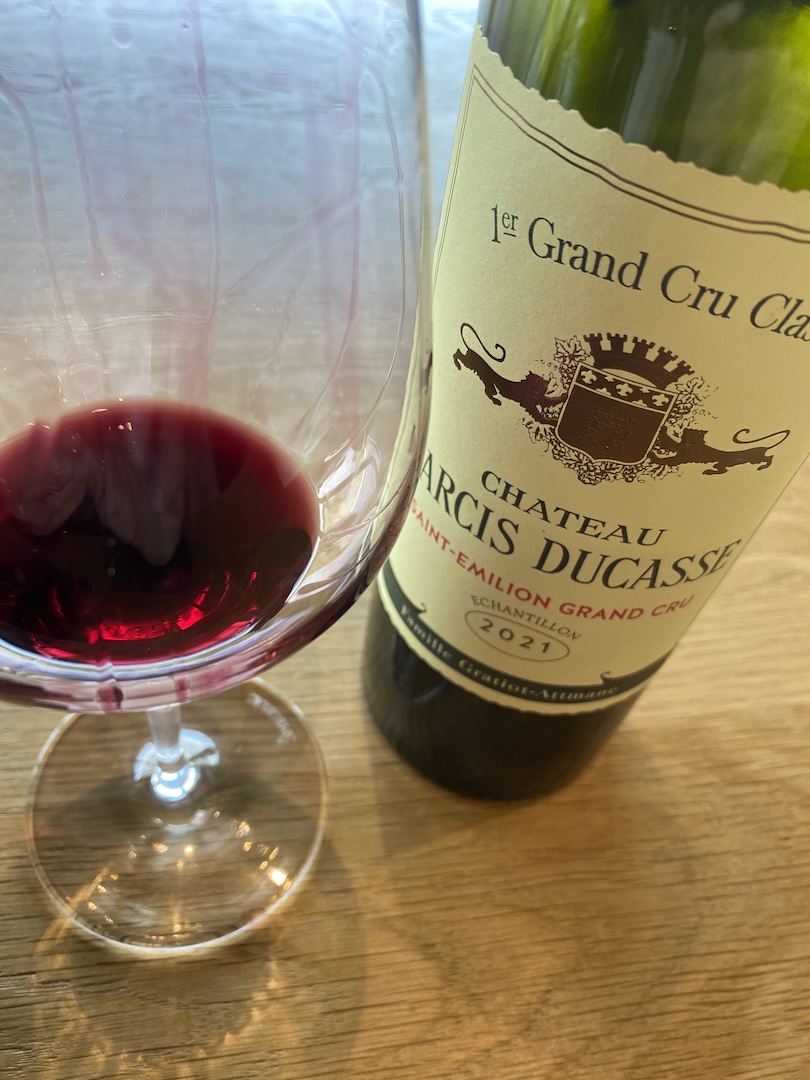
Wet stone excellence
Château Larcis Ducasse Premier Grand Cru Classé – A top wine of 2021! Using only grapes grown from vines on the slope, which drained late spring and summer rainfall well, this blend of 86% Merlot and the rest Cabernet Franc exudes fruit purity, palate refinement and excellent, vivid wet stone “minerality”. It clocks in at 13.5% alcohol and is ageing in 50% new oak. Tasted three times (at Pavie Macquin, at the UGCB and at Joanne) with consistent notes: darn good stuff, with tannic ripeness and spicy fruit that pleases. 94-96+
Château Laroque Grand Cru Classé – Great work here by director David Suire, as this blend of 99% Merlot and one per cent of Cabernet Franc goes to show that 2021 did not necessarily favor one grape over another, or one side of the Estuary over another. Here we have elegance, salinity and density, cropped at a healthy 41 hectoliters per hectare, with 45% of the harvest going to the grand vin. What should be excellent value, too. 93-94
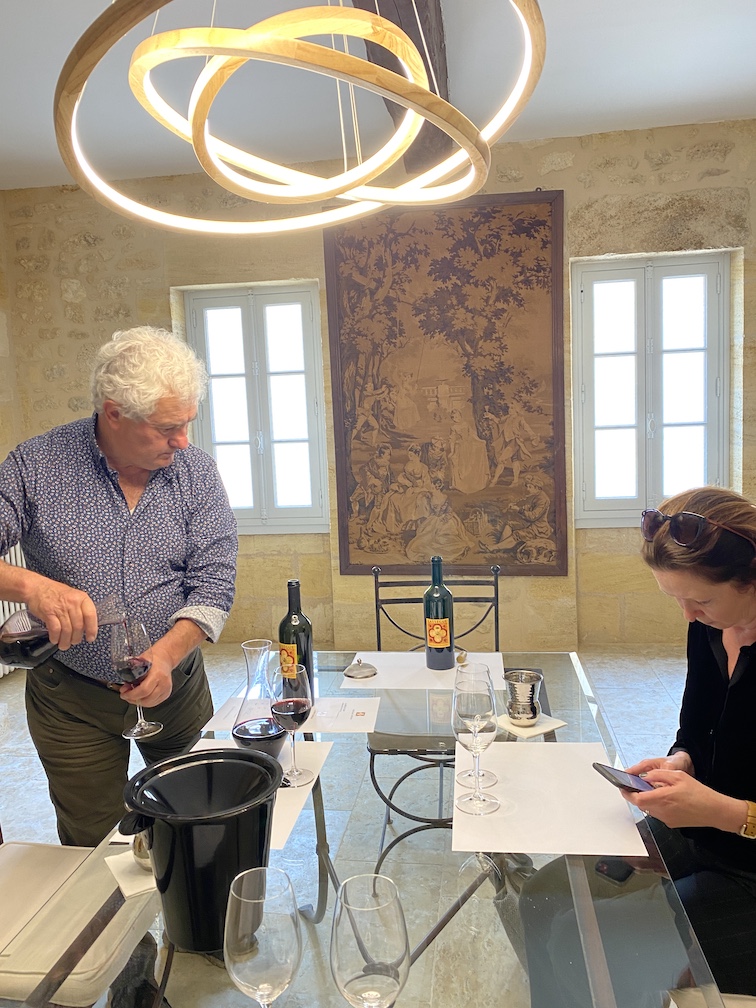
With of Pierre Seillan of Château Lassegue and Jane Anson
Château Lassegue Grand Cru – Impressive, with ripe red berry notes of raspberry and autumnal cranberry, black fruit and saffron. Estate director Pierre Seillan insisted on not adding sugar. His 54th vintage since 1967, just ahead of his 72nd birthday, Seillan said that no pumping was done to preserve fruit purity. Instead, he submerged the cap during fermentation with juice from another vat, “like infusion”. Blending 55% Merlot, 35% Cabernet Franc and 10% Cabernet Sauvignon, the wine was “especially great for the Cabernet Francs, which reminded me of my days in the Loire Valley”, he said. Expected to age between 12 and 14 months in barrel. 13,5% alcohol. 93-94
Château Monbousquet Grand Cru Classé – Tasted at Château Pavie, with new director Raphael Maurin , the wine succeeds for the vintage. While tannins are tight, great care has been taken with extraction (some vat bleeding to concentrate Merlot juices), resulting in pleasant fruit and a good mid palate. I like the crushed tobacco note from the Cabernet Franc, which makes up 15% of the blend (70% Merlot and 15% Cabernet Sauvignon complete the wine). Clocks in at 13.67 alcohol with a pH of 3.67 and ageing in 50% new oak. 91-93

For now, the only “official” A rated grand cru classé
Château Pavie Premier Grand Cru Classé A – Tasting the wines of Gérard Perse, I note the persistent oaky style, which makes the wine less appealing (to me). However, this factor has decreased in impact, as many Perse wines have excellent terroir, first and foremost Château Pavie. Fans will like the 2021, as the wine has depth and power, with an iodine aspect for freshness along with ripe black and red fruit. The palate of this blend of 52% Merlot, 30% Cabernet Franc and the rest Cabernet Sauvignon impresses with depth and density. However, I feel that the finish dries a tad with excess new oak tannins. Score higher if you like the style. 92-94
Château Pavie Macquin Premier Grand Cru Classé – Another fine entry, tasted on three separate occasions, and this blend of 79% Merlot, 19% Cabernet Franc and 2% Cabernet Sauvignon exudes a polished nose of ripe fruit and black tea, although the finish has austerity, which barrel aging should resolve. Bravo for impressive power and density. Clocks in at 13.5% alcohol. 93-95

Gavin Quinney assessing barrel samples at the well organized tasting by the Grand Cercle at Château La Dauphine. Also a winemaker (Château Bauduc), Quinney made more rosé than red in 2021…
Château de Pressac Saint Emilion Grand Cru Classé – With an anticipated blend of 73% Merlot, 17% Cabernet-Franc, 7% Cabernet Sauvignon and a bit of Carménère and Malbec, aging in 50% new oak (225l and 500l) plus 5% amphorae, this wine conveys vibrancy and smoothness. Good job! 91-93
Château Le Prieuré Grand Cru Classé – This blend of 91% Merlot and 19% Cabernet Franc impresses with a mid palate density and clean, ripe fruit, even though it dries out a bit on the finish. 90-91
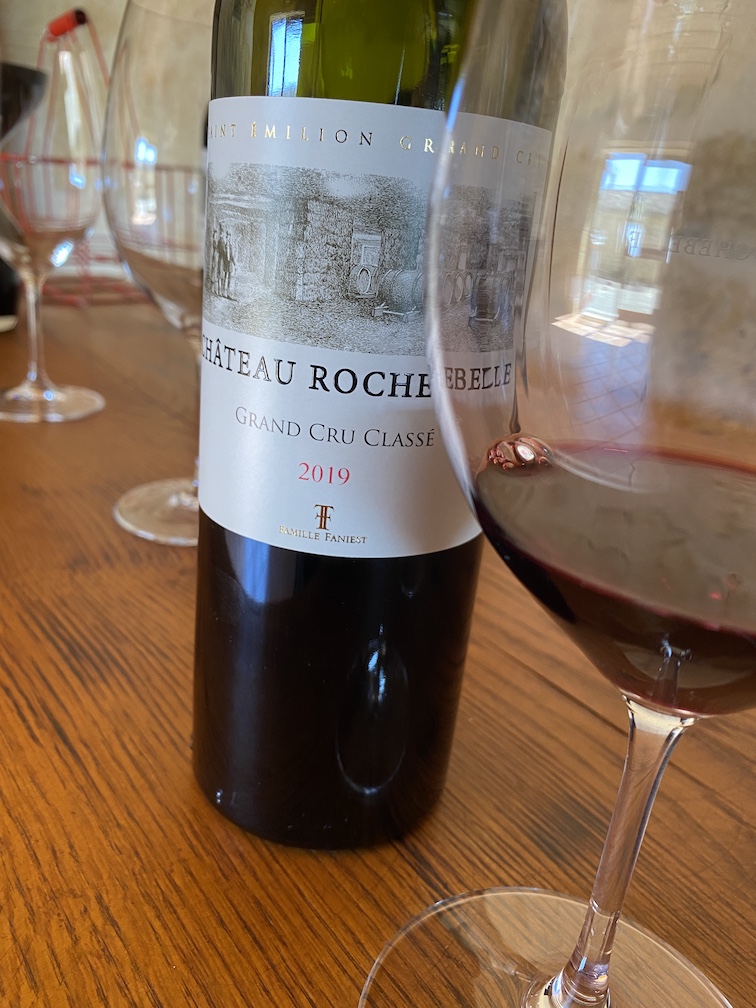
While not matching the 2019, the 2021 is excellent.
Château Rochebelle Grand Cru Classé – Crisp red autumnal ripeness and wet stone (three hectares on the limestone plateau) transcend the vintage, which co-owner Emilie Faniest called one of “endurance” as it required “human investment and vigilance from the beginning to the harvest.” The estate lived up to the task as the 80% new oak is well integrated, and the wine clocks in at 13.8% alcohol without added sugar. I also love the mid-palate juiciness as experienced too at the negociant Joanne. Cropped at 30 hectoliters per hectare, an impressive showing indeed. 93-95
Château Sansonnet Grand Cru Classé – Oak sheen, as ever, with 80% new oak, tends to dominate the palate, but I like the underlying power from this blend of 85% Merlot, 8% Cabernet Franc and 7% Cabernet Sauvignon, and ageing should make this special wine. 91-93
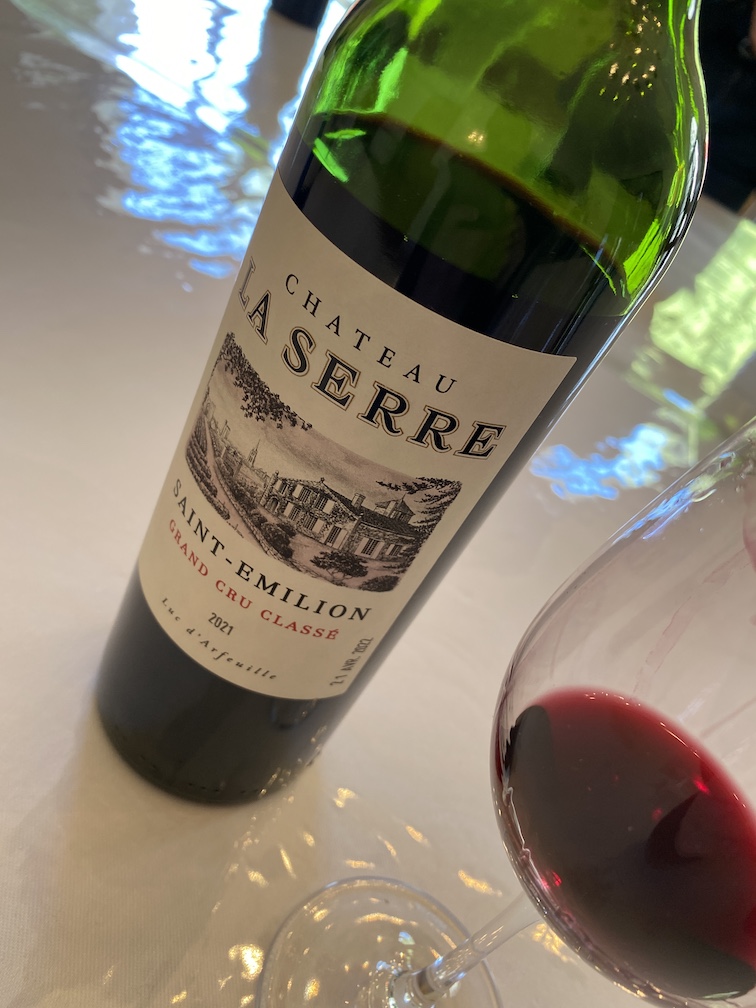
Château La Serre Grand Cru Classé – When tasted among the wines of the JP Moueix portfolio, this blend of 80% Merlot and 20% Cabernet Franc shined bright, even among tough competition. Charming ripe fruit, mid palate sap and smooth tannin resulted in having the rare characteristic in this vintage of seeming “effortless” in qualitative appeal. Bravo! 93-94
Château Soutard Grand Cru Classé – Distinct Earl Grey tea aromatics with red fruit from this interesting blend of 70% Merlot, 18% Cabernet Franc, 7% Cabernet Sauvignon and 5% Malbec. I like the tannins, with nuance and edge, but not aggressive. A successful Saint Emilion at the UGCB tasting in Bordeaux. 13% alcohol. 91-93
Château Tour Saint Christophe Grand Cru – With wet stone, freshness and density, this estate has been on a mission of excellence at least since 2015 (one of my picks for September promotion to Grand Cru Classé). A windy microclimate helped to dry out the vines after the rains. It blends 80% Merlot and 20% Cabernet Franc, aging in 40% new oak, clocking in at 13.6% alcohol. 91-93+
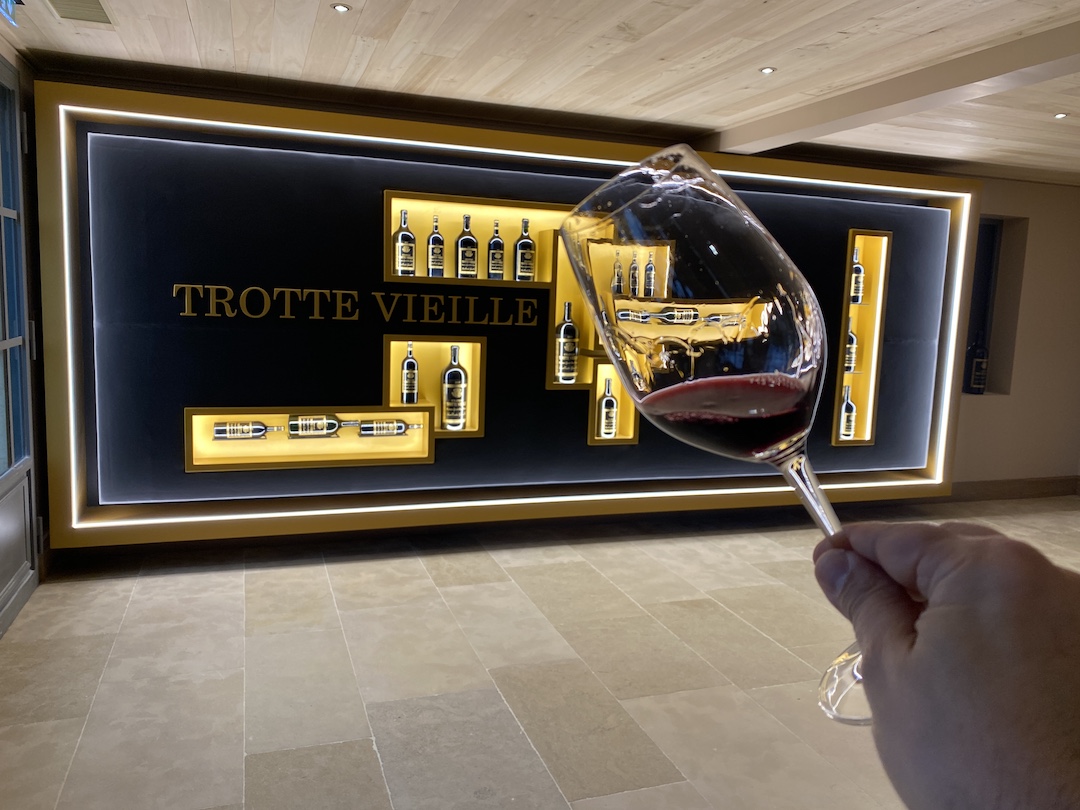
2022 saw new cellars inaugurated at Château Trotte Vieille
Château Trotte Vieille Premier Grand Cru Classé – Described in the vintage brochure as a “grueling year”, the result of hard work proves positive, as this blend of 54% Cabernet Franc, 45% Merlot and 1% Cabernet Sauvignon comes across elegant and refined, with minty and floral aromatics from the Cabernet Franc, leading to a delicate palate for which the estate certainly extracted carefully. A great success for the vintage. 93-95
Château La Dauphine Fronsac – Certified both organic and biodynamic, this blend of 80% Merlot and 20% Cabernet Franc conveys nuance and refinement in its tannins. Aging in 30% new oak should “fill out” the mid palate and be better than some may think. Pleasing mint on the finish. 91-92+
Château de Fontentil Fronsac – Some oak notes on the nose, but with smooth tannin on the palate and pleasing juiciness in the middle. Although it finishes somewhat tight, with a hint of vaguely drying tannin, let’s see how it performs from bottle… 90-92
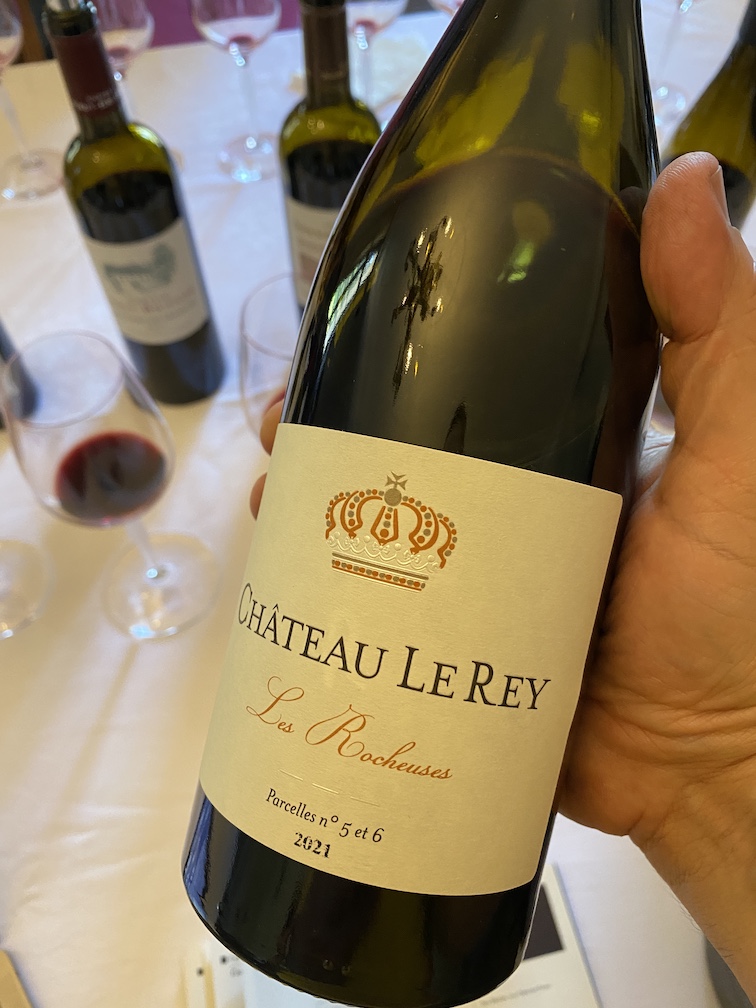
2021 red chestnuts include modestly priced wine
Clos Lunelles Castillon Côte de Bordeaux – One of the properties owned by Gérard Perse, this blend of 80% Merlot and 10% each of Cabernet Sauvignon and Franc displays rich aromatic opulence with some tea leaf freshness. The palate conveys energy and substance, and I would recommend ordering it at a restaurant to impress friends: “2021 was a challenging vintage, but some estates did well, like this one.” 14.45% alcohol, with a pH of 3.58 and ageing in 50% new oak. 91-93
Château Puygueraud Francs Côte de Bordeaux – High on a plateau, vines suffered little frost damage, and the estate counted among those that fought efficiently against mildew. The wine displays cool blue fruit, with a mint aspect from the 19% Cabernet Franc (the rest is 81% Merlot). Late harvesting aimed for fine ripeness. 13.5% alcohol. 91-93
Château Le Rey Les Rocheuses Castillon Côte de Bordeaux – Buy alert! An excellent blend of 80% Merlot and 20% Cabernet Franc, with vivid notions of wet stone and a lovely tonic note on the finish, neither drying nor bitter. The wine transcends the vintage: beyond just being pleasant and avoiding the pitfalls. Aging in 20% new oak. 92-94
Château La Vieille Cure Fronsac– Cropped at 40 hectoliters per hectare, a wine that has oak aspects (aging in 70% new oak) but not overplayed. Even if the finish comes a bit austere, you get decent fruit from this blend of 80% Merlot, 15% Cabernet Franc and 5% Cabernet Sauvignon. The wine will benefit from barrel ageing. 91-92
Château de France (Pessac-Léognan) – The palate has grip, with mid-palate succulence, too. A wine that over-performs the vintage, even if the finish seems a tad attenuated. 91-93
Château La Louvière (Pessac-Léognan) – A just-ripe enough plum aromatic aspect with wet stone notions and cool blue fruit. The palate has juiciness, as well. As such the wine comes across as one of the more successful wines tasted at the Union of Pessac-Léognan reds. 91-92
Clos Marsalette (Pessac-Léognan) – Smooth and balanced, with soft fruit and careful extraction. Buy with confidence for its fresh, leafy character, which also is attractive. 91-93
Château Beauregard Ducasse (Graves) – While it lacks the dimension of most wines from Pessac-Léognan, I like the medium concentration, fruit ripeness and fine depth from this blend of 50% Merlot, 40% Cabernet Sauvignon and 10% Petit Verdot. 89-90
Château Bouscaut (Cru Classé de Graves Pessac-Léognan) – While I love the white at this estate, the red seems more dominated by some edgy tannin. On the other hand, this blend of 47% Merlot, 44% Cabernet Sauvignon and 9% Malbec, clocking in at 13.3% alcohol, emits pleasing red and black fruit aromas and flavors, so let’s see how it evolves after the barrel ageing. 89-91
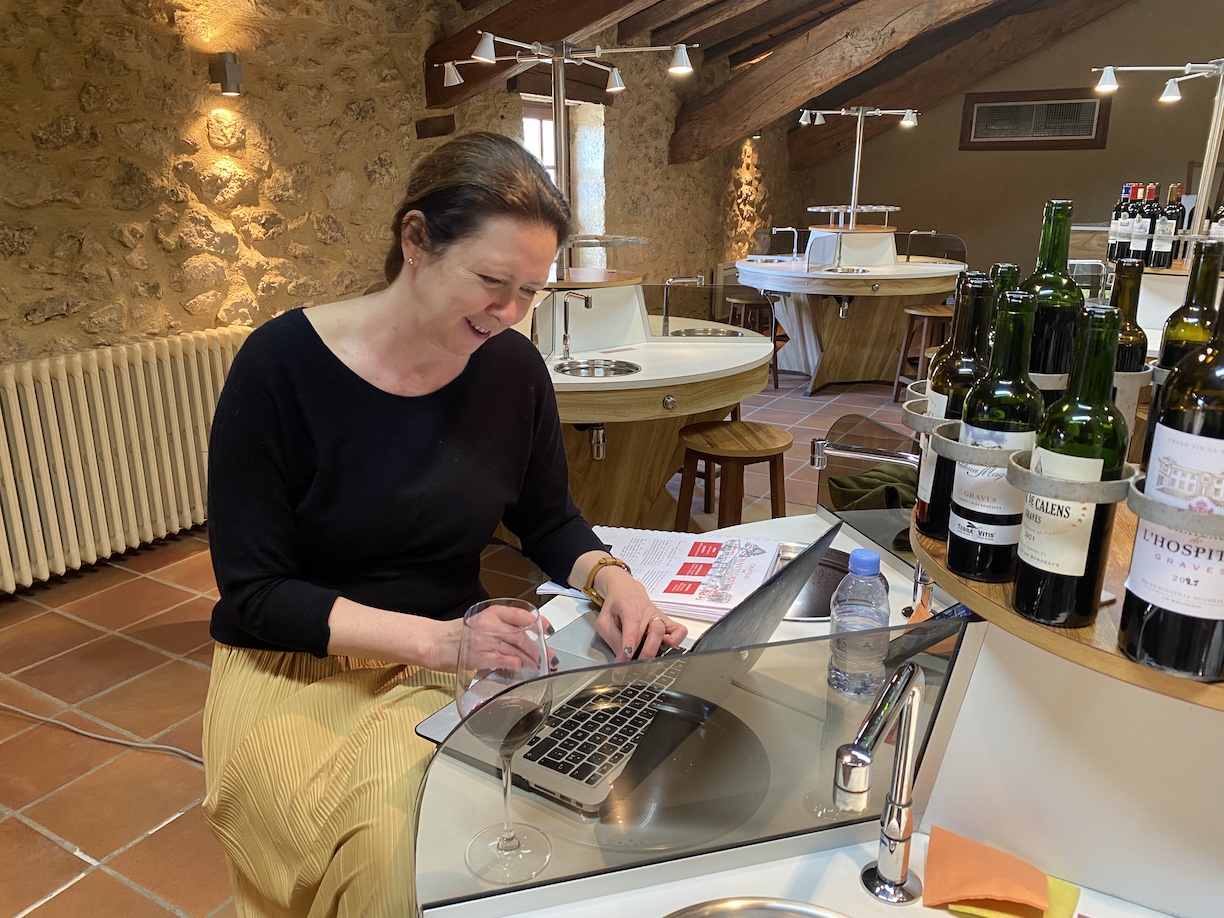
With Jane Anson tasting at the Maison de Graves.
Château Brondelle (Graves) – This blend of 60% Cabernet Sauvignon, 35% Merlot and 5% Petit Verdot is a sleeper of Graves, with contour on the smooth palate. Perhaps a bit of a tannic wall on the finish but overall refined with nicely integrated oak. Tasted both at the Maison de Graves and the Grand Cercle with consistent notes. 89-91
Château Carbonnieux (Cru Classé de Graves Pessac-Léognan) – I like the finesse, and depth, although the tannins dry on the finish. So, you get a vibrant attack, but an underwhelming finish. Let’s see from bottle… 89-91
Château de Cérons (Graves) – This blend of 60% Merlot and 40% Cabernet Sauvignon comes across smooth albeit just a touch under-ripe on the finish. Keeping in mind the savory mid-palate, it should develop nicely over time. I had a similar impression at the Grand Cercle. 88-90
Clos Floridene (Graves) – One of the best aromatic profiles from the Maison de Graves tasting, with ripe fruit and tobacco and wet stone. A blend of 50-50 Cabernet Sauvignon and Merlot, the palate also exudes clove and a touch of tealeaf. Even if the tannins are a bit austere on the finish, the oak ageing (30% new oak) should soften things. Tasted again at the Grand Cercle, with similar impression. Bravo! 91-92+
Château Couhins-Lurton (Cru Classé de Graves Pessac-Léognan) – Not as drying as some other wines and indeed rather supple – even if the wine reflects he challenge of the vintage for sunny ripeness, or lack thereof. Pretty good, in context. 91-93
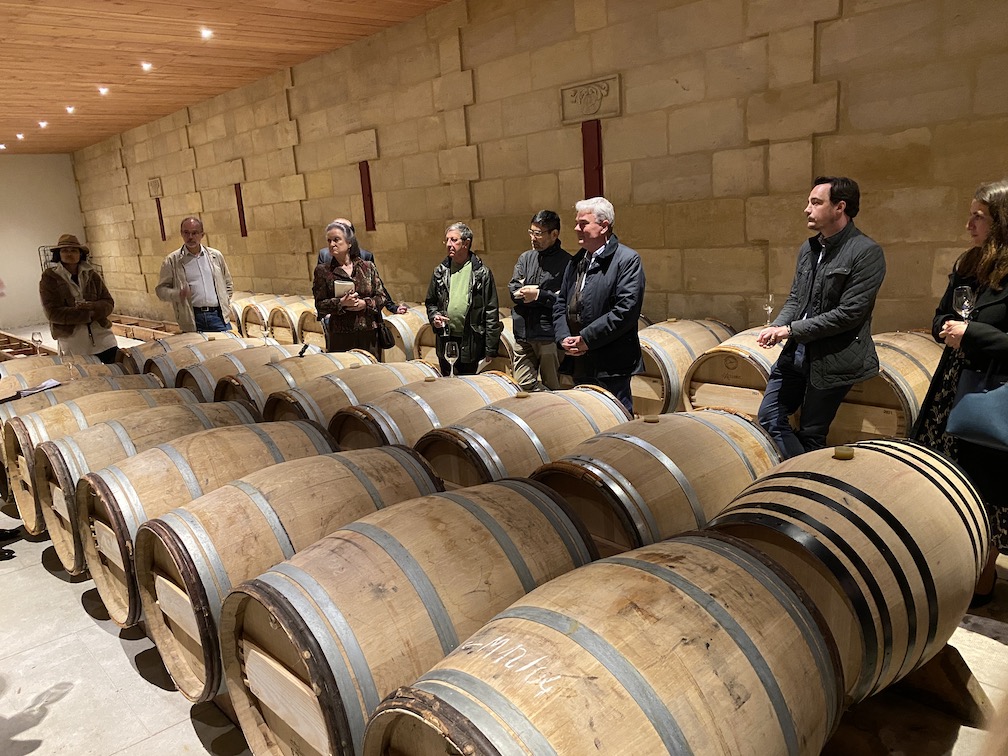
Olivier Bernard with media at Domaine de Chevalier
Domaine de Chevalier (Cru Classé de Graves Pessac-Léognan) – With the most Cabernet Sauvignon at the estate since 1984, this blend of 80% Cabernet Sauvignon and just 10% Merlot (with 5% each of Petit Verdot and Cabernet Franc) exudes intensity, power and tannic edge. With barrel ageing, it should turn very appealing. How did the estate get the juicy tannins? Owner Olivier Bernard was at pains to explain how in recent, solar vintages, there was a need to not press the pedal for ripeness, and that 2021 was the opposite: “We needed more time for the Cabernets to ripen,” he explained. Very few Merlots, because mildew and rain had bloated the grapes. The result is a wine that exceeds vintage expectations. Tasted twice with consistent notes. 93-95
Château de Fieuzal (Cru Classé de Graves Pessac-Léognan) – This has a somewhat “aimless airiness” about it; certainly in contrast to the more typical orchestral, ostentatious style of the estate. While I like the lack of hardness or harshness, with a brownie cake aspect from the Merlots (50% of the blend), it lacks enough mid-palate density. Could the barrel aging fill out the palate enough for greater interest? Let’s see. 90-92
Chateau Haura (Graves) – This blend of 83% Cabernet Sauvignon and 17% Merlot, ageing in 33% new oak exudes a certain polish that transcends the vintage. Leafy Cabernet with juiciness on the mid palate, again. More tannic edge to the wine as compared to the Clos Floridene, tasted just before at the Maison de Graves. Similar results as tasted at the Grand Cercle. 90-92

Served over lunch at the tasting, the 2008 can be compared to the 2021.
Château Haut Bailly (Cru Classé de Graves Pessac-Léognan) – Tannic finesse, rather sumptuous ripeness and impressive acidity/tannin balance (so important in this vintage) make the cut. The success in this blend of 65% Cabernet Sauvignon, 22% Merlot, 10% Petit Verdot and 3% Cabernet Franc is testimony to the excellent team and to the new cellars inaugurated for this vintage. Warmer, gravel soils in the cooler summer worked well, as pickers waited through to 12 October to get optimal ripeness. Alcohol is 13% and aging in 50% new oak. Let’s see how it tastes from bottle. 94-96
Château Haut Selve (Graves) – While I like the brightness and relatively refined tannins, the mid palate lacks density. Let’s see how “amplified” it will get with barrel aging. 88-89
Château Latour Martillac (Cru Classé de Graves Pessac-Léognan) – While I like the brisk attack, with a decent mid-palate, the finish is marked by some hard tannin, alas, but not astringent. Barrel ageing should soften matters. Conservative score for the moment. 91-93
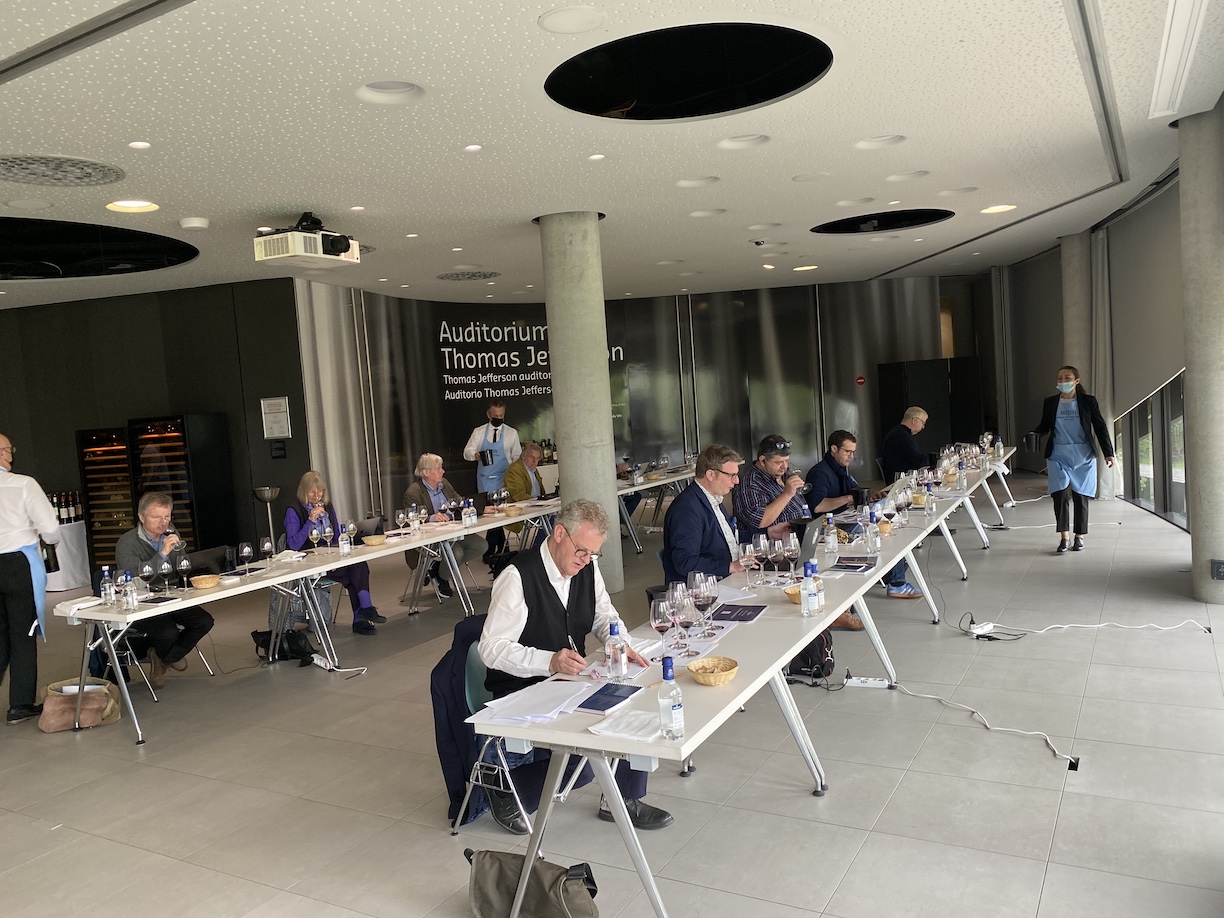
Assessing the 2021 vintage at the well organized UGCB sessions at the Cité du Vin
Château Malartic Lagravière (Cru Classé de Graves Pessac-Léognan) – Like the Latour Martillac, I like the attack from this wine and the palate exhibits even more density, with the depth and power of a 67% Cabernet Sauvignon in the blend, but not quite the follow through you’d expect, with some hard tannin. Time in barrel should resolve matters. 92-93+
Château Olivier Cru (Cru Classé de Graves Pessac-Léognan) – Kudos to the estate for achieving both finesse and mid-palate grip in this blend of 55% Cabernet Sauvignon, 40% Merlot and the rest Petit Verdot, as the tannins do not dry out so much. This wine has more brightness than expected, at least based on two samples tried on separate occasions. 92-93
Château Pape Clement (Cru Classé de Graves Pessac-Léognan) – Foreboding tannic power can impress “blockbuster” fans, but not for lovers of finesse. On the other hand, the wine has balance with an admirable (for the vintage) coating of richness. I can see this turning out nicely with barrel ageing. Strong effort from Pape Clément – and lovers of the style will be pleased. 93-95
Château de Rochemorin (Pessac-Léognan) – Tasted after de Cruzeau at the Pessac-Léognan union tasting, this blend of 61% Merlot, 30% Cabernet Sauvignon, 6% Petit Verdot and 3% Cabernet Franc has more mid-palate sap and ripe enough plum by comparison, even if the finish comes off a touch mouth puckering. A sample at the Grand Cercle seemed smoother. 89-91
Château Roquetaillade La Grange (Graves) – Tasted twice, with different results, although it has more palate density than most other red Graves that I tried, with savory black fruit, albeit a finish that is just a bit like hitting a wall, albeit not drying. A better tasting experience at the Grand Cercle, with superior salinity on the finish. Cropped at 30 hectoliters per hectare, the blend should be about 60% Merlot and 40% Cabernet Sauvignon. 90-91+
Château Smith Haut Lafitte (Cru Classé de Graves Pessac-Léognan) – Tried the red 2021 just before a vertical of vintages ending in -9, including the 2019 and 2009 vintages! As with other top notch estates, SHL came out well in 2021, with a stronger impression of ripe fruit than most reds of the vintage. I also like the mid-palate density from this blend of 63% Cabernet Sauvignon, 33% Merlot, 3% Cabernet Franc and one per cent of Petit Verdot. Aging in 60% new oak, the wine conveys fresh red and black fruit ripeness, expected high-toned acidity and rather smooth tannins and with pleasing lift on the finish. 93-95
Chateau Villa Bel-Air (Graves) – I rather liked this, even if the tannin is a bit hard on the finish. Overall, an “honest take” on the vintage as the acidity comes off a bit too high, perhaps, but overall you get balance and friendliness. 88-90
Listrac / Médoc / Haut-Médoc / Moulis
Chateau Belgrave (Haut Médoc) Fifth Growth – Rather hard tannin but it should improve with some barrel ageing. Still, Clarke so far has impressed me most, among the wines tasted at the UGCB at the Cité du Vin. 91-92+
Château La Cardonne (Médoc) – I like the wet stone aromas emanating from this blend of 52% Cabernet Sauvignon, 43% Merlot and 5% Petit Verdot. The palate may be a touch austere, but not astringent, and barrel ageing, in 40% new oak, should resolve things. Here is another example of a northern Médoc estate (on the highest plateau in the Médoc, five miles northwest of Saint Estèphe) benefitting from less rainfall. This Cru Bourgeois Supérieur clocks in at just over 13% alcohol. 91-92
Château Citran (Médoc) – Like many other estates in 2021, this blend has more Cabernets than usual with 60% Cabernet Sauvignon, 20% Cabernet Franc and 20% Merlot – and it counts among the better showings, with some tannic edge but quite smooth. Will benefit from ageing in barrel. 90-92
Chateau Clarke (Listrac) – The best among the Listrac wines that I tasted. With a lovely nose, bright attack albeit tannins a bit hard. But successful wine for the vintage. There is some tartness on the finish. 91-92
Château Les Grands Chênes (Médoc) – Another estate in the north, vines close to the Gironde Estuary: this blend of (a whopping) 70% Merlot and 30% Cabernet Sauvignon performed nicely, with ripe tannin. Sure, not a hugely ripe vintage, but in context, a fine showing, one to pick from a restaurant list and explain why the northern Médoc did well in a challenging vintage (impress your friends 😂). 91-93
Château La Lagune (Haut Médoc) Third Growth – Although a bit austere, this blend of 70% Cabernet Sauvignon, 20% Merlot and 10% Petit Verdot shows breed, with mid-palate concentration and a subtle tannic edge that will soften with aging and be worthy for shorter term enjoyment, until, say, the 2020 is ready. 92-93
Château Potensac (Médoc) – I love the fresh forest aspect to this blend of 40% Cabernet Sauvignon, 34% Merlot, 23% Cabernet Franc and 3% Petit Verdot, exuding mint, plum and cassis. Wet stone, chalky aspects please, as the tannins are rather refined. Yet again a northern Médoc estate that did quite well in the vintage. 92-94
Château Poujeaux (Moulis) – As is so often the case, my favorite Moulis estate has a respectable showing in this vintage, too. For fans of Poujeaux, this blend of 50% Cabernet Sauvignon, 45% Merlot and 5% Petit Verdot has medium bodied density with fine ripe fruit, even if it pales against the three previous vintages in terms of depth and length. But go for it for completing your vertical. 91-92
Château La Tour de (Médoc) – Another northern estate that benefitted from less rain, and we encounter fine concentration and riper fruit, although the tannins seem a bit austere. Nonetheless, I can see how barrel ageing will smoothen this blend of 60% Cabernet Sauvignon, 35% Merlot and 5% Petit Verdot. As the estate notes in its brochure on the vintage: “the work and the terroir were decisive”. Indeed, not a bad showing! 91-93
Alter Ego of Palmer – The best “second wine” of the vintage. In 2021, I like this even more than Château Palmer, so call me crazy. But in this vintage what the estate does not like to call a “second wine” comes across at least as equal to the grand! With 60% Cabernet Sauvignon, 32% Merlot and 8% Petit Verdot, I love the ripe fruit, smooth tannin, and impressive structure. The price should be excellent for the quality. Clocks in at 13% alcohol. 94-96
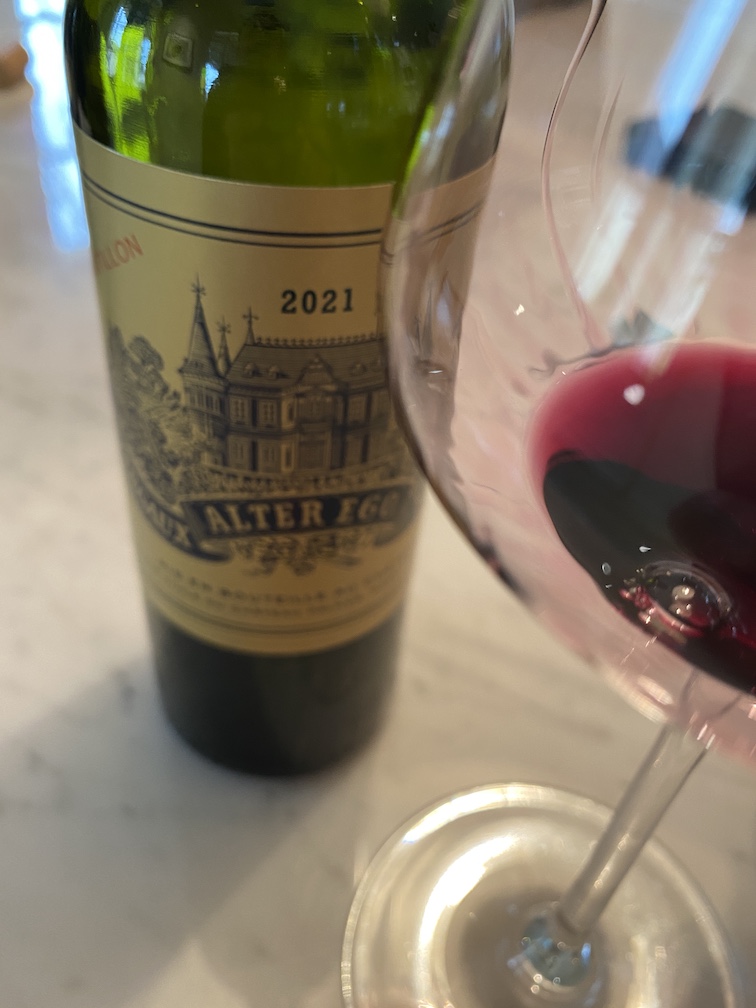
Call me crazy.
Château Brane-Cantenac Second Growth – With perfumed aromas of faded rose, white pepper, black tea leaf, and nutmeg spice, this blend of 74% Cabernet Sauvignon, 22% Merlot and bits of Carmènere, Petit Verdot and Cabernet Franc mightily impresses for its robust mid palate. Overall refined tannins albeit a touch drying on the finish, but barrel aging should resolve this. 94-96
Château Cantenac Brown Third Growth – A blend of 73% Cabernet Sauvignon and 22% Merlot, this counts among the top Margaux assessed at the UGCB. Pleasing red fruit aromas emerge and the palate is supple if not all that substantial: you get a sense of an estate that “plays it safe” with extractions, but with some mid palate density and charm. Reminds me of a 2011. 92-93
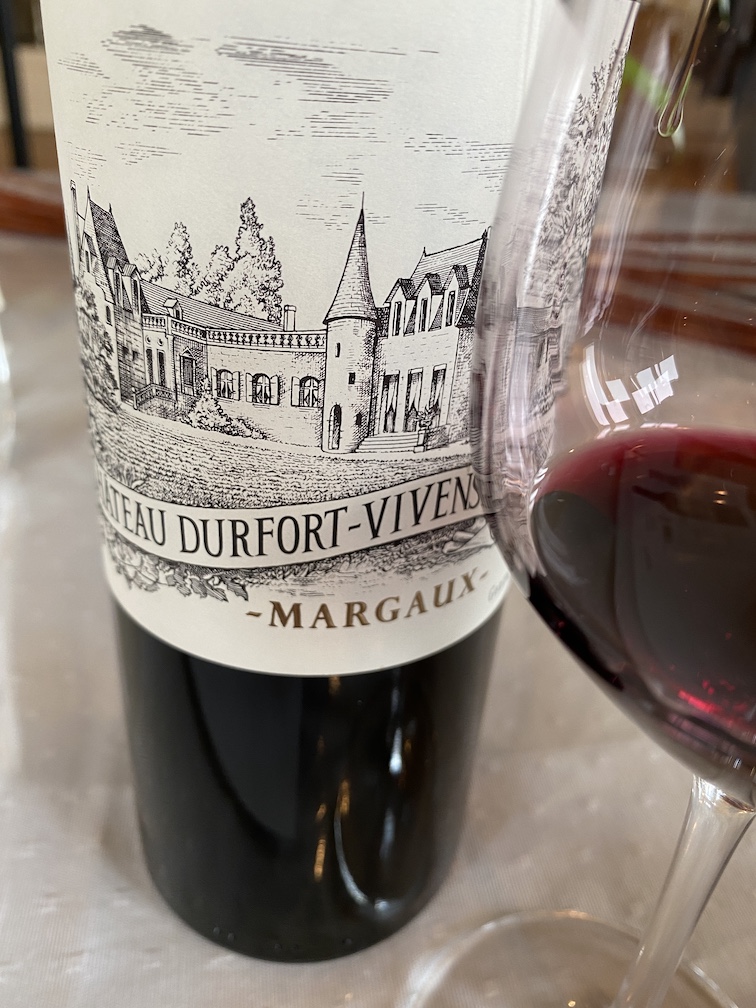
Close to 100% Cabernet Sauvignon in 2021
Château Durfort-Vivens Second Growth – A very successful Margaux this almost 100% Cabernet Sauvignon blend (actually, 97%) exudes forest freshness and elegance, with some of the softest tannins of the vintage. “2021 is not a perfect vintage”, stressed owner Gonzague Lurton as we started to taste. Not only did frost and mildew affect mainly the Merlots, but also harvest-period rains diluted them: “The qualitative difference between Cabernet Sauvignon and Merlot was clear”, Lurton said. At least added sugar was organic, in line with the estate’s certified organic and biodynamic nature. Like Berrouet at Petrus, Lurton thinks of 1988 for “aromas” and 1986 for tannins. For more modern comparisons, it seems a cross between 2011 and 2014. 93-94
Château d’Issan Third Growth – This blend of 65% Cabernet Sauvignon, 30% Merlot and 2% each of Cabernet Franc and Malbec plus 1% of Petit Verdot benefits yet again from added varieties from the acquisition of Pontac Lynch, so you get enticing floral and spicy aromas leading to a palate with grip and structure, although the tannins are a bit strict. I like the mid palate juiciness that transcends the vintage, and would think that aging will mellow the austerity enough to make this a success. 93-95
Château Maléscot St Exupery Third Growth – With black and red fruit and spice, this blend of 49% Cabernet Sauvignon, 38% Merlot, 8% Cabernet Franc and 5% Petit Verdot exudes fine mid palate concentration, although the tannin can seem a bit hard. Barrel ageing should sort this out, and we shall see from bottle. 92-93+
Château Margaux First Growth – This blend of 87% Cabernet Sauvignon and 8% Merlot gives off lovely floral lead pencil and juicy mid palate blackberry aspects: quite special in 2021. The finish has slightly strict tannin, which should be resolved with barrel aging. The IPT index of 75 is the same as in 2019, but the difference is greater luminosity from the 2019 vintage. Still, a very strong effort here! Solid job as well from the second wine, Pavilion Rouge. 95-96
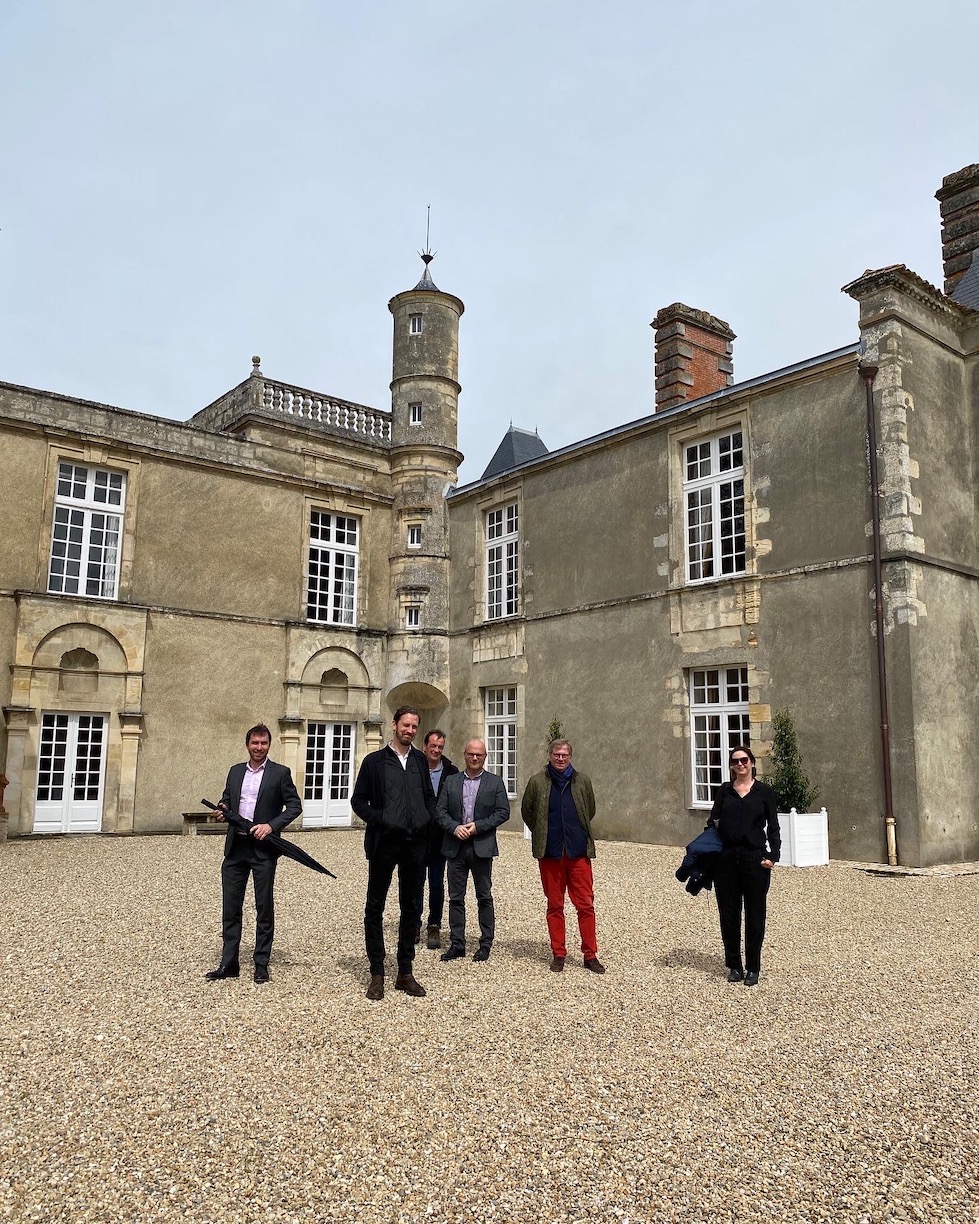
Happy tasting crew at Château d’Issan
Château Marquis d’Alesme Third Growth – I like the spicy, floral, forest fresh, aniseed and white pepper aromatics, and the attack has briskness. But the tannins come across rather hard on the palate. They should be softened by the oak aging, so fingers crossed for this blend of 51% Cabernet Sauvignon, 40% Merlot, 6% Petit Verdot and the rest Cabernet Franc, aging in 60% new oak. The wine clocks in at 13% alcohol with a 3.8 pH. 91-93
Château Palmer Third Growth – Interesting how much more Merlot is included – 56% – as compared to 41% Cabernet Sauvignon (and 3% Petit Verdot) in the blend. By contrast, Alter Ego (see note, above) is “more like Château Margaux” quipped director Thomas Duroux. In any case, the grand vin delivers succulence for the vintage, so Palmer succeeds with ripe red and black fruit, showing off how well Merlots can do on its gravel soils, even in a challenging vintage: Duroux indeed explained how it was a challenge to ensure technical ripeness as opposed to phenolic, meaning that some parcels were too low in sugar and too high in acidity. Palmer in 2021 has quite a bit of tannic power as well as savory fruit. Clocks in at 13.5% alcohol. 93-95
Château Prieuré Lichine Fourth Growth – Potpourri nose, rather nuanced and quite surprisingly soft tannins make this a very good Margaux in a challenging vintage. Some austerity on the finish, but barrel ageing should soften it. 92-93
Château Rauzan-Ségla Second Growth – The subtle salinity and distinct notes of blood orange freshness, rose petal and forest strawberry make this a success. The 75% Cabernet Sauvignon and 25% Merlot aging in 60% new oak exudes tannic power and fine mid-palate concentration that makes it worthy. While neither as exuberant nor as dense as 2019 or 2016, an excellent job, with freshness on the finish. 93-95
Château Siran – The 60% Cabernet Sauvignon dominates the blend (28% Merlot, 11% Petit Verdot and 1% Cabernet Franc) with iodine cassis freshness. Complemented by pleasing charm and mid-palate density, it is a worthy candidate for Siran fans. 91-93
Château du Tertre Fifth Growth – Citing excellent natural drainage from the terroir could be a factor, but this blend of 64% Cabernet Sauvignon, 20% Cabernet Franc, 10% (!) Merlot and 6% Petit Verdot has impressive mid-palate sap. I love its inner core of juiciness, too, reflecting both finesse and charm, although some drying tannin is noticeable on the finish. Let’s see how barrel aging will defuse this. 93-94
Château Tour de Mons – Frank and fresh, with clay limestone soils revealing freshness and palate density in this vintage. Only the second vintage to have been hand harvested, and it shows. An estate to watch, as I will soon mention in a feature on Margaux for Decanter Magazine. 91-93
Clos du Marquis – An excellent effort from this estate, where the 14% Cabernet Franc at this pre natal stage seems most vivid with mint freshness, along with floral notes. The 67% Cabernet Sauvignon lends structure and cassis flavors, while the 19% Merlot some touches of plum. And what I like about this estate is that the pH at 3.69 was not as low as in 2011, a vintage that seems comparable. In 2011, it was 3.45, so more noticeable. The alcohol reaches almost 13.5% A wine of fine balance. 93-94+
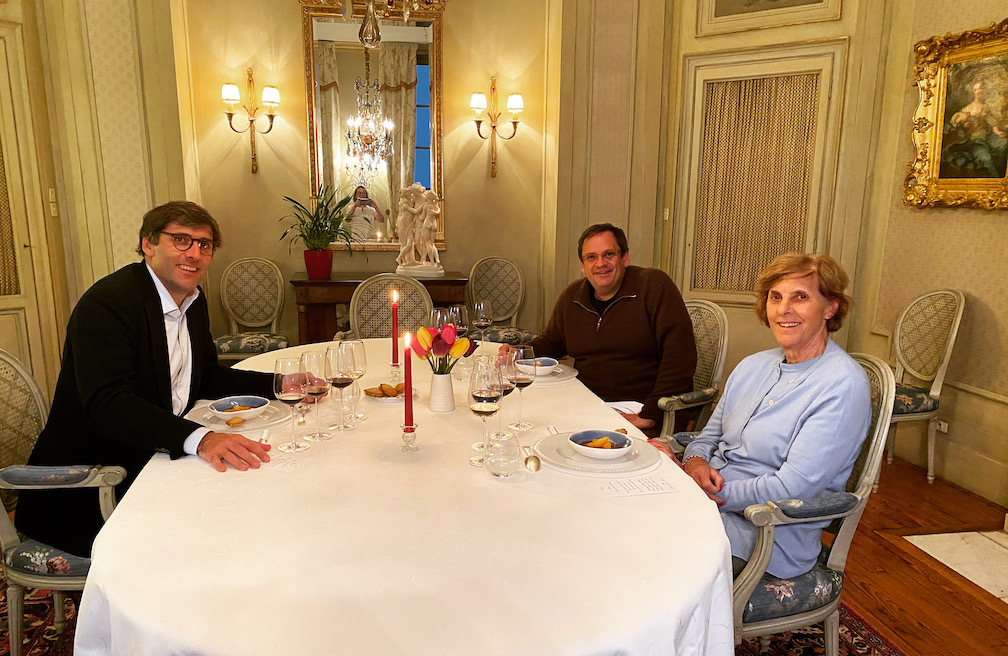
Son and mother: With François-Xavier and Evelyne Maroteaux at Château Branaire Ducru
Château Langoa Barton Third Growth – As much as this estate has been coming on strong in recent vintages, it was tougher going in 2021 as this blend of 61% Cabernet Sauvignon, 36% Merlot and 3% Cabernet Franc reveals somewhat austere tannin. But give it time, as the mid palate has fine density and oak ageing should smoothen matters. 92-93
Château Branaire Ducru Fourth Growth – A solid performance comes from this estate, with smoother-than-expected tannins for the vintage. The talented team under Jean Dominique Videau has done a great job to manage the balance between acidity and tannin, and I tip my hat. They took time to harvest with maximum ripeness as well. While lacking the mid-palate density of a top vintage, the quality of the tannin is such that barrel ageing will yield lovely wine. As owner Francois-Xavier Maroteaux said: “Classic”. 92-94
Château Beychevelle Fourth Growth – This blend of 56% Cabernet Sauvignon, 40% Merlot, 3% Petit Verdot and 1% Cabernet Franc recalls the power of Rauzan Ségla in Margaux. It is an impressive showing with ripe fruit aromas. And while the tannins convey some “2021” rawness, they are smoother and more racy than expected, to clearly benefit from barrel ageing. Great work. 93-95
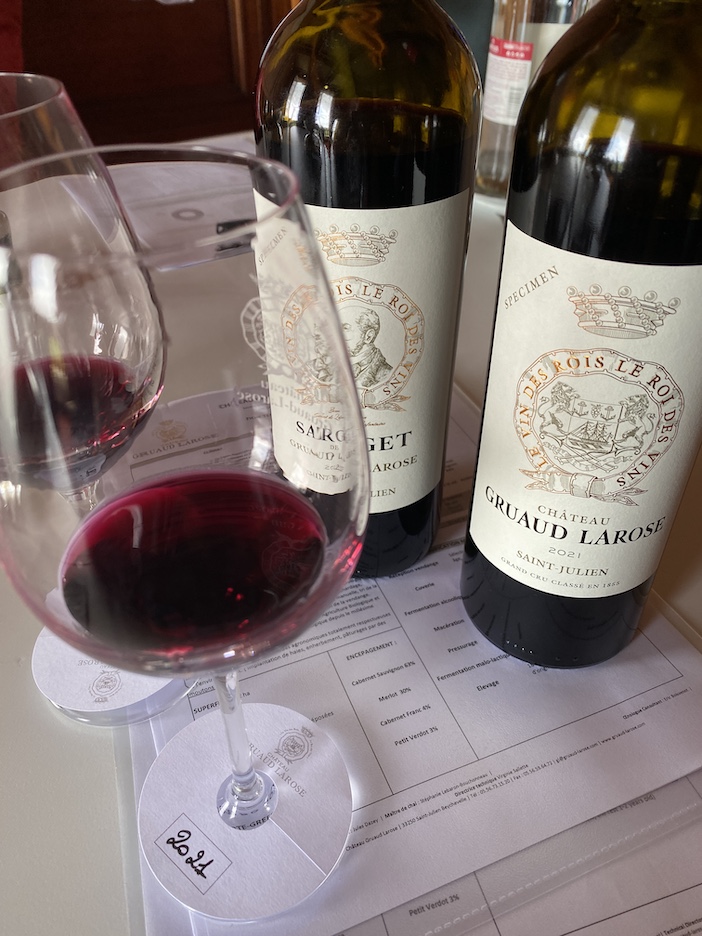
A fine Gruaud, and the second wine also tasty.
Château Gruaud Larose Second Growth – It was nice to return to this estate after several years. Many tasters say that it counts among the successes of the vintage in Saint Julien, and I agree. Already after tasting the fine and fresh second wine, the Sarget, the grand vin has a “deeper” nose, as you can sense the palate depth that should be coming. And the palate is rather elegant, quite floral in fact, from start to finish, and Nicolas Sinoquet explained how important it was to be careful with extractions, in a blend with the most Cabernet Sauvignon in recent history: 84% along with 12% Merlot and 4% Cabernet Franc. Careful use of press wine added concentration. My only caveat is that for fans of Gruaud’s power and density, this comes in second gear, when compared to a vintage like 2020 or 2019. But it has such fine tannin and such engaging floral aromatics that we should better wait for the barrel aging to “do its stuff” and reassess afterwards. 93-95+
Château Léoville Barton Second Growth – A tour de force in a challenging vintage. This blend of 84% Cabernet Sauvignon, 11% Merlot and 5% Cabernet Franc exudes breed and class, reflecting the positive experience that I had had with Léoville Las Cases. I would indeed say that Barton has crafted one of the wines of the Left Bank, and if the price is right, a wine to purchase. Smooth tannins, refinement and a wine that will benefit from ageing in barrel. Alcohol is 13.1% and the wine is ageing in 60% new oak. 94-96
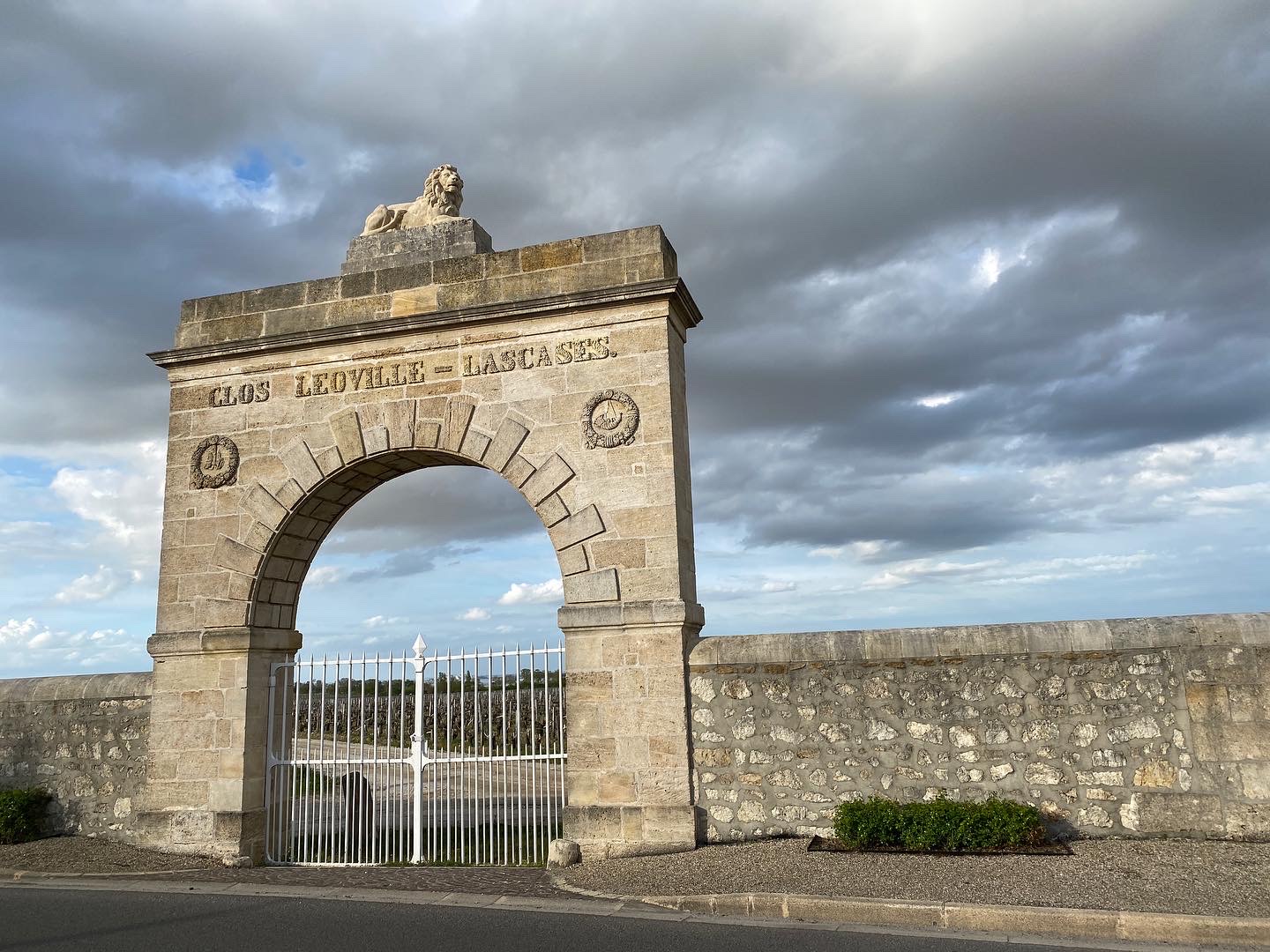
Iconic wine built to last
Château Léoville Las Cases Second Growth* – A candidate for wine of the vintage, this estate comes out swinging with black and blue (ripe) fruit, superb salinity and wet stone freshness, floral and tobacco, with full body, but nuanced on the palate. Aging in 85% new oak, this blend of 80% Cabernet Sauvignon, 15% Cabernet Franc has but … five per cent of Merlot. Does the tannin seem a touch hard on the finish? Sure, but a trifle for 2021 (honestly, I was expecting more austerity) and barrel aging will resolve that. The team has pulled a rabbit out of the 2021 hat. I am looking forward to trying this again once bottled, as it promises to be a long term LLC, with more power than expected from this vintage. 95-97
Château Léoville Poyferré Second Growth – Completes the success of the Léoville trio in this vintage. Already the second wine, Pavillon de Léoville Poyferré, is supple and agreeable, which is difficult in 2021 (with some exceptions). Tasted at the estate, the talented team was up for the task, opting for some osmose inverse and vat bleeding of the Merlots. A complicated harvest because the effect of frost and later grape shattering (coulure) followed by rain left Merlot bunches with uneven ripening and large grapes. “So we had to ensure more density from the Merlots, which make up 26% of the blend,” explained director Sara Lecompte-Cuvelier. “We did not want to deny our Merlots as part of the blend”, she said. Later picking ensured ripeness. The 60% Cabernet Sauvignon, (also 9% Cabernet Franc) and 5% Petit Verdot were picked later in October, despite initial concerns from the vineyard manager whose team had faced many challenges, so why risk harvest rain? But rain was minimal and the ripeness works here with a seductive nose as expected from this estate, leading to a juicy and rather substantial mid-palate very promising for barrel aging. The only aspect that reminds you of the vintage is a slight tightness to the tannin on the finish and a lack of the same exciting brightness from, say, 2016. Otherwise, I like the vivid notes of plum, strawberry, tea and tobacco leaf. Aging in 85% new oak. 94-96
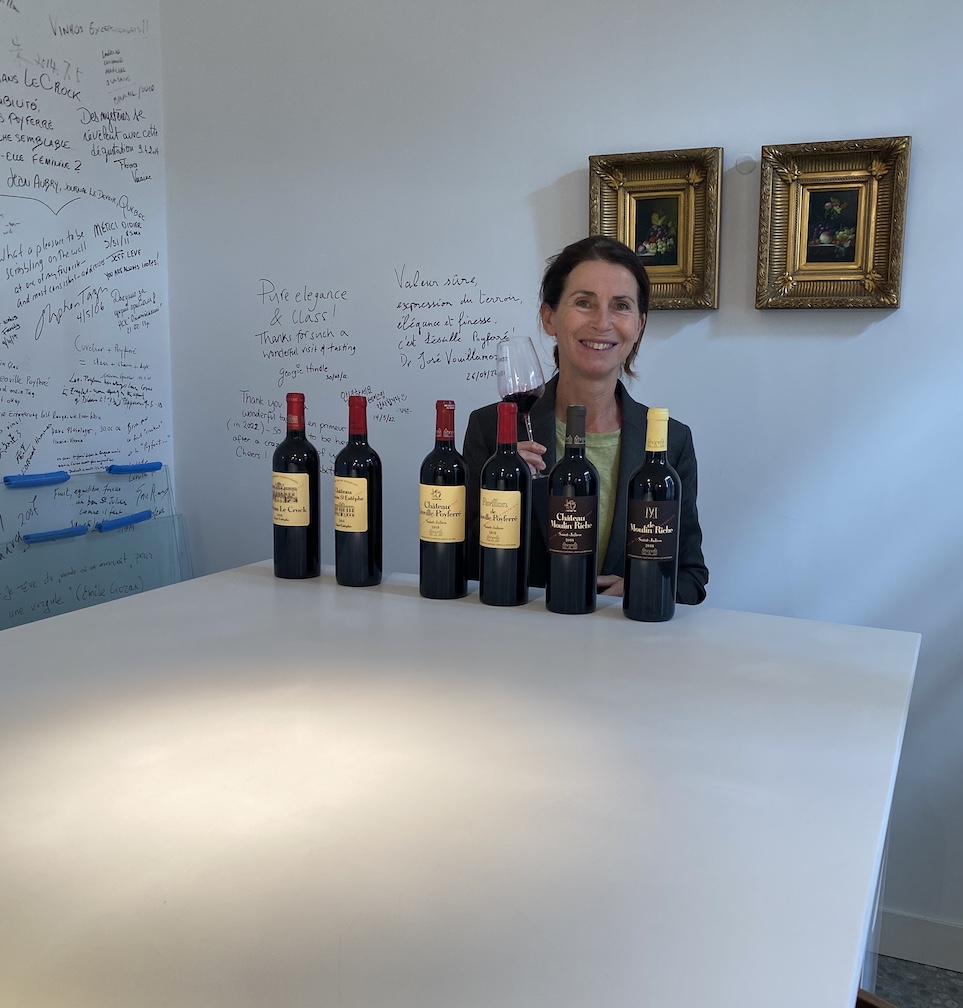
Great work by the entire team at Léoville Poyferré, with director Sara Lecompte-Cuvelier
Château Saint Pierre Fourth Growth – This blend of 70% Cabernet Sauvignon, 14% Merlot, 9% Cabernet Franc and 7% Petit Verdot conveys both black fruit and licorice with pleasing mid palate sap, even if the tannins have some edginess to them. But I like the overall balance, and this should turn out to be a fine Saint Julien indeed. 92-93
Château d’Armaillac Fifth Growth – Tasted with Clerc Milon, this estate compared more favorably – and not just in the sense that “it tends to be friendlier when younger”. The blend of 63% Cabernet Sauvignon, 22% Merlot, 13% Cabernet Franc and 2% Petit Verdot, clocking in at 13% alcohol, exuded succulent mid-palate sap, and even if it also had some “2021” raw tannin, its more impressive “core of ripeness” and fine mid-palate concentration will (more clearly) benefit from “rounding out” in barrel. Aging in 50% new oak. Tasted twice with similar results. 92-94

Philippe Casteja hosting lunch after tasting the wines of Borie Manoux at Château Batailley
Château Batailley Fifth Growth – One of the better wines from the Left Bank. While it exudes some raw tannin, it also has impressive mid-palate concentration that augurs well for ageing in barrel, with notes of wet stone and touches of chocolate. I got a similarly positive experience from this blend of 76% Cabernet Sauvignon, 20% Merlot and 2% Petit Verdot as tasted at the estate. 93-95
Château Clerc Milon Fifth Growth – Tasted at the recently inaugurated cellar space at Château d’Armaillac, it was not the easiest year for Jean Emmanuel Danjoy to direct all the Baron Philippe de Rothschild properties, as 2021 is the first full vintage since he replaced Philippe Dhalluin. I like the underlying power and density in this blend of 59% Cabernet Sauvignon, 28% Merlot, 10% Cabernet Franc and 1.5% each of Petit Verdot and Carmenère, clocking in at 13% alcohol. There is cassis and red berry fruit along with some green meadow aspects. The tannins come across somewhat rigidly, so we need to wait until the aging (55% new oak) to taste again from bottle to see the extent to which the palate will have softened. For now, a conservative range. 91-93
Château Haut Bages Libéral Fifth Growth – I love the crushed strawberry and lead pencil aromatics and the rather juicy mid palate from this blend of 90% Cabernet Sauvignon and 10% Merlot (once again, one of the highest percentages of Cabernet at this estate ever). As you get to the finish, there is a pleasing note of wet slate or even chalk. While the tannins are a touch austere and it lacks the density of a 2020, for example, this is an excellent performance for the vintage. 92-94
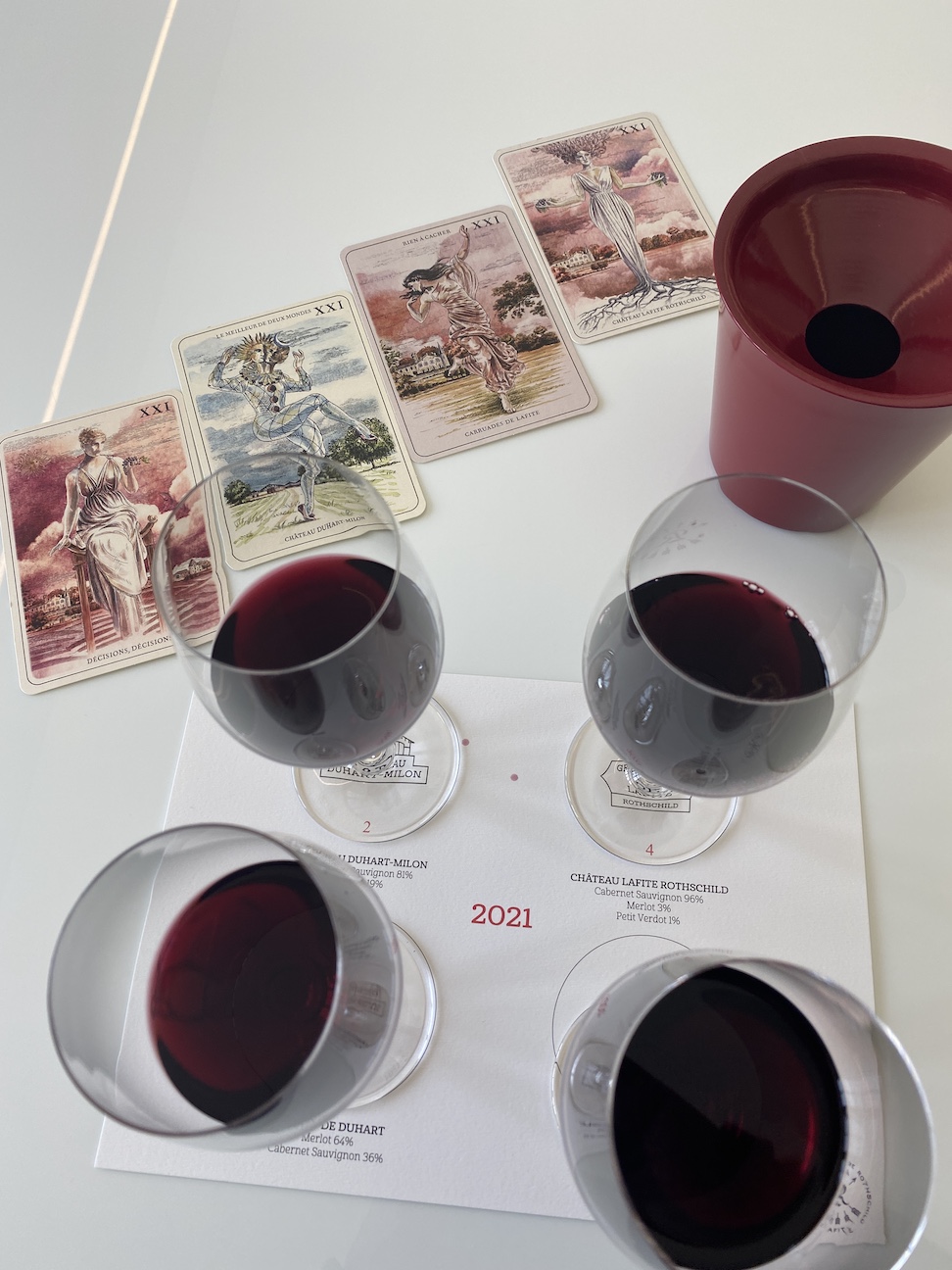
Tasting at Lafite Rothschild
Château Lafite-Rothschild First Growth* – Candidate for wine of the vintage, at least on the Left Bank, this blend of 96% Cabernet Sauvignon, 3% Merlot and 1% Petit Verdot is nothing short of exquisite. At just 12.6% alcohol, the cool blue fruit, forest freshness and wet stone seduce. At first, I was not so excited. time in glass showed subtle power from very fine grained tannin – rare in 2021 – proving the point that great terroir can work wonders in a challenging vintage. Harvest from 22 September to 8 October, and the wine is aging in 90% new oak. 95-97
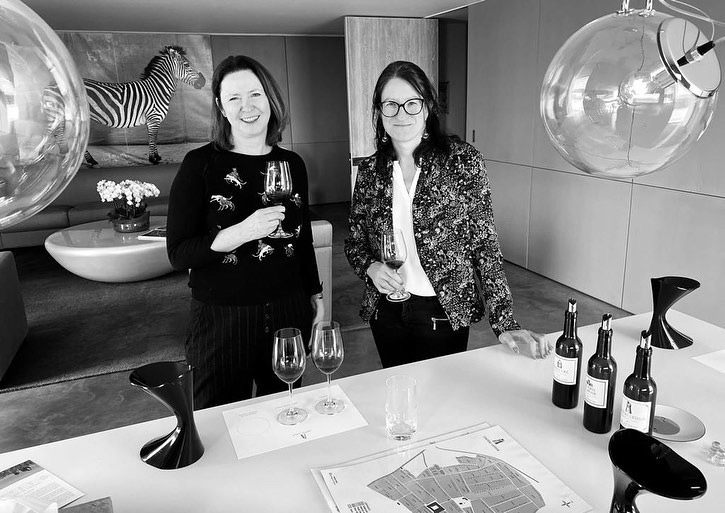
Two talented ladies: Author and wine writer Jane Anson with Hélène Genin of Château Latour
Château Latour First Growth* – A top red of the vintage. As often was the case, even at this prestigious first growth in Pauillac, the second (and, in this case, third) wines create less excitement than from a top vintage. I am sure that Forts de Latour for example will be fine, but if comparable in price to the 2020, it is a no brainer. As for this grand vin, the wine cuts through the vintage mustard. Indeed, the blend is a whopping 96% Cabernet Sauvignon and just four per cent Merlot, which was hit hard by mildew. At 13.1% alcohol, Latour transcends 2021, with tannins less rustic than in, say, 2011, confirmed technical director Hélène Génin. Impressive density, with a tannic edge not as hard as most others tend to be. It is present, mind you, but of such fine grain. As for taste sensations, you get lead pencil and rose bud, in a svelte palate. It reminds me of the 2014, as tasted from barrel. Génin emphasized that the estate preferred not to add sugar. It helps to have an exceptional terroir that historically “buffers” extreme temperatures, so the “cold and gloomy summer” described by the estate brochure was not as bad here as in other locations. Furthermore, significant soil water reserves did not prevent some hydric stress to occur at the end of August, which helped to concentrate (naturally) grape juices. A challenging vintage, but Latour put in a very strong effort, with a later harvest – ending on 10 October – to ensure maximum ripeness. 95-97+
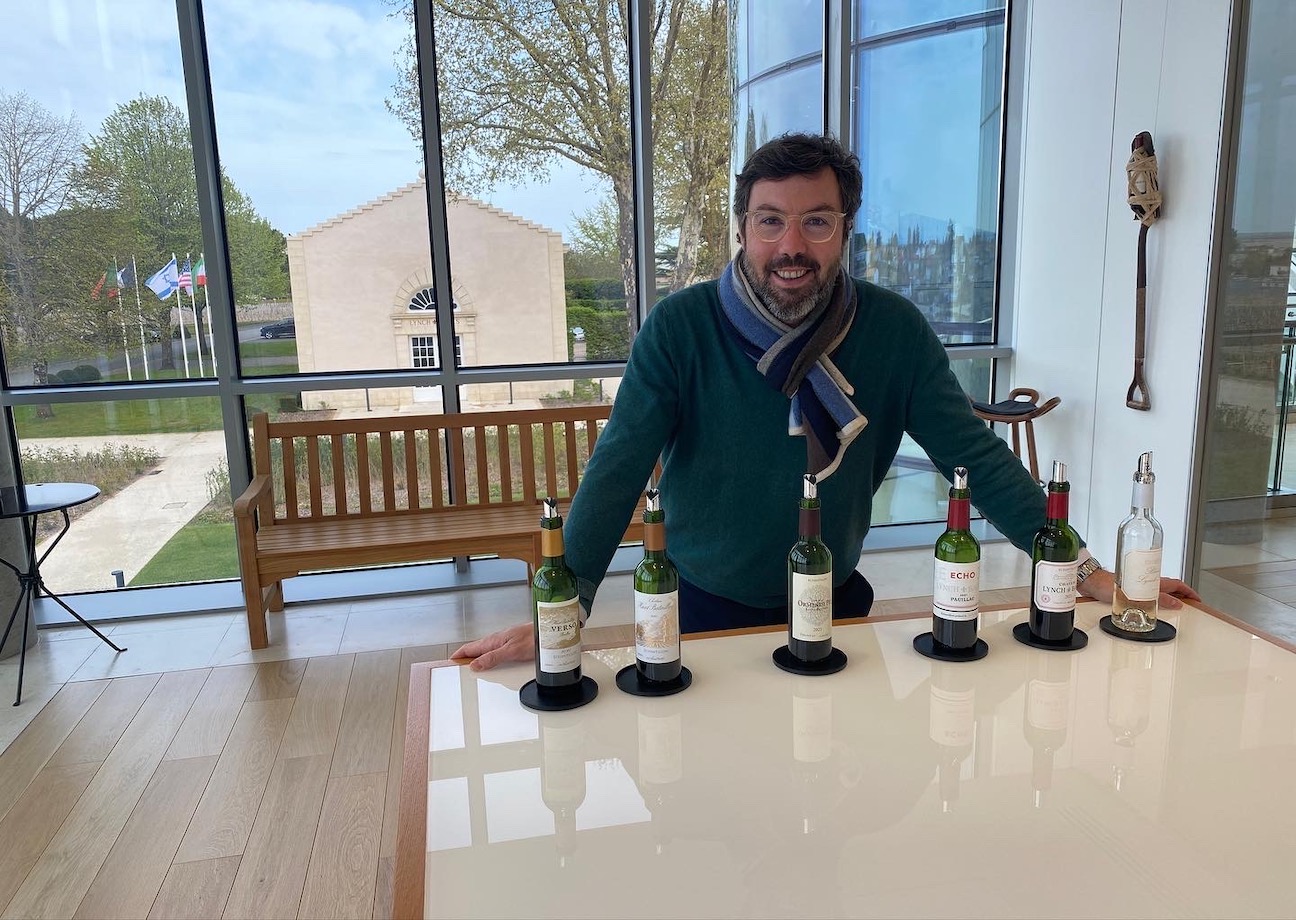
Jean-Charles Cazes at Château Lynch Bages: among the highest tannin indices of the Médoc in 2021
Château Lynch Bages Fifth Growth – Among the highest tannin levels encountered on the Left Bank at a whopping 90 IPT, this blend of 67% Cabernet Sauvignon, 25% Merlot, 5% Petit Verdot and the rest Cabernet Franc is not short on power. Aging in 75% new oak, it should be softer and more approachable when off shelf, but there is a bit of austerity on the finish that mirrors the vintage character. What reassures is the blackberry and cassis fruit. It recalls the 2008 and 2014 vintages in many respects. 93-95
Château Lynch Moussas Fifth Growth – Cool mint aspect. This blend of 72% Cabernet Sauvignon and 28% Merlot communicates elegance and smooth tannin. Somehow, the Castejas also pulled a rabbit out of the 2021 hat. Kind of like Château de Fieuzal in Pessac-Léognan, soft extractions reveal elegance and barrel aging should fill out the (perhaps too?) soft mid palate. 91-92
Chateau Mouton Rothschild First Growth – Laudable grip and structure from this blend of 89% Cabernet Sauvignon 10% Merlot and 1% Cabernet Franc. With black and red berry notes and intriguing pepper and juniper spice, it has smooth texture. The 100% oak aging will expand the mid palate, but I can’t help but feel a lower gear for this normaly opulent estate. Indeed, the tannic index is rather low at 59 (compared with, say, Lynch Bages, at 91). Numbers are not everything, but they add up. I like the freshness on the finish to be sure. 93-95

In May 2022, I attended a stupendous vertical of Château Pichon Longueville Baron, to celebrate 37 years of work by Jean Rene Matignon, who is leaving the estate. We also tasted the 1959 and 1961 vintages. Report coming later!
Château Pichon Longueville Baron Second Growth – While tasting at the estate, I wrote the word “gorgeous” for the aromas: Loads of pencil lead and cassis, so you are getting the “genuine article” here, and better than expected density from the palate. The highest proportion of Cabernet Sauvignon, stressed director Jean-René Matignon: 88% along with 12% Merlot. Nevertheless, the tannins have a certain austerity, but the wine should soften these with the barrel aging (70% new oak). Overall, a very good performance for the vintage with higher score potential. Let’s see from bottle. 94-95
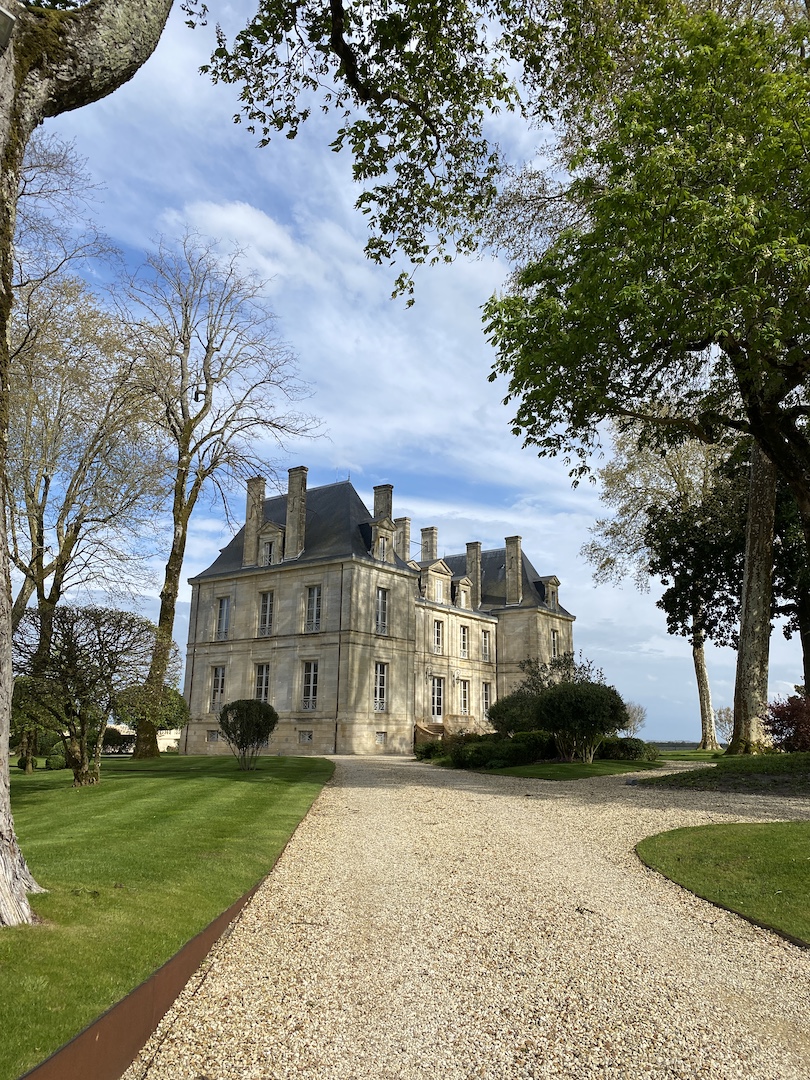
Hard earned 2021 charm at the Comtesse
Château Pichon Longueville Comtesse de Lalande Second Growth – Impressive, powerful Pauillac, while exuding house style elegance. Tannin quality (IPT 76) imparts seriousness, smoothness and mid-palate tension. Director Nicolas Glumineau decided to end the two-week harvest on 5 October, before expected rainfall forecast for 7-9 October (neighbor Château Latour continued through to 10 October). Would he have gained something after that rainfall? I am uncertain, but the Comtesse succeeds in 2021, while eliciting more “tea leaf” aspects than brighter and riper fruit from a sunnier vintage. We are not in 2020. With 88% Cabernet Sauvignon (10% Cabernet Franc and just two per cent Merlot), this is the most Cabernet since the 2013 vintage, at 100% Cabernet Sauvignon. Success came from careful picking, although yields just 15 (!) hectoliters per hectare, owing to mildew and coulure for Merlots between mid-June and mid-July: “A nightmare,” remarked Glumineau. Tasted twice, with similar results (UGCB and at the estate). The wine is aging in 65% new oak for 19 months; it will be racked less to maintain more freshness. Just .38 per cent chaptalisation for “better balance,” Glumineau said. 94-96
Château Pontet Canet Fifth Growth – The first wine I tried from the vintage and its laser focus and freshness impress. Cassis, cool blueberry fruit, hints of spice all subtle and refined. Mildew pressure is second fiddle to the team, who handled the vintage vagaries well, maintaining organic and biodynamic certifications. A juicy mid palate transcends the vintage with tannic backbone. The release price mirrors 2020, but the brand is strong. This blend of 58% Cabernet Sauvignon, 32% Merlot, 6% Petit Verdot and 4% Cabernet Franc is being aged in 50% new oak, 35% amphora and 15% in one-year barrels; it clocks in at 13% alcohol. 94-96
Réserve de la Comtesse – One of several successful second wines in the vintage not known for very good second wines, this blend of 56% Cabernet Sauvignon, 36% Merlot and 8% Petit Verdot (40% of harvest) exhibits floral and plum aspects, a suave palate and a sense of refined tannin. Using 14% press wine from the Cabernet Sauvignon augmented density. An excellent second wine indeed, clocking in at 12.9% alcohol and it may age in up to 50% new oak (the estate was not yet decided) for about twelve months. 91-93
Château Beau-Site – Proves again how well the appellation shows in the vintage, with black fruit and mocha. Blending 73% Cabernet Sauvignon, 25% Merlot and 2% Petit Verdot, I like the palate density and freshness. 91-93
Château Capbern – This blend of 70% Cabernet Sauvignon, 28% Merlot and 2% Petit Verdot further convinced me of the special quality of the Saint Estèphe appellation, with more than a fair share of bright red fruit and finesse of tannins. I like the zing to the wine with lift on the medium finish. Nice work! 92-94
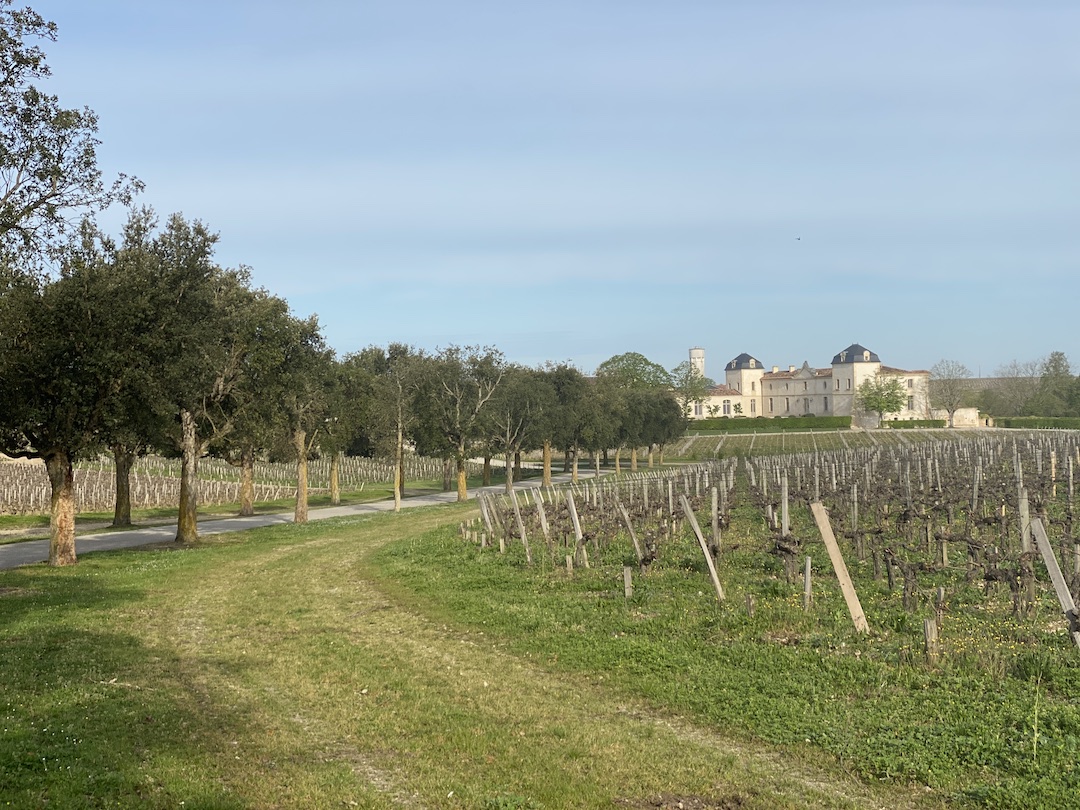
The road to Calon Ségur: a great success in 2021
Château Calon Ségur Third Growth – You have something special when your second wine, Le Marquis, already conveys red cherry and blackberry notes. “As if we are in a different vintage”, quipped director Vincent Millet. Indeed, Château Calon Ségur comes across legitimately noble in its expression of tobacco leaf, cool blueberry fruit, with mid-palate juiciness, leading to a fine, long finish! The blend of 81% Cabernet Sauvignon, 11% Cabernet Franc, 7% Merlot and 1% of Petit Verdot excites. Could Millet have anticipated the sunless summer? He explained how workers de-leafed both sides of the vines at the end of June to aerate the grapes against possible mildew, even if not much came. Indeed, this exposed grapes to more possible sunlight for natural concentration (along with a drier late August). Aging in 100% new oak, the wine clocks in at just under 13% alcohol. 94-96
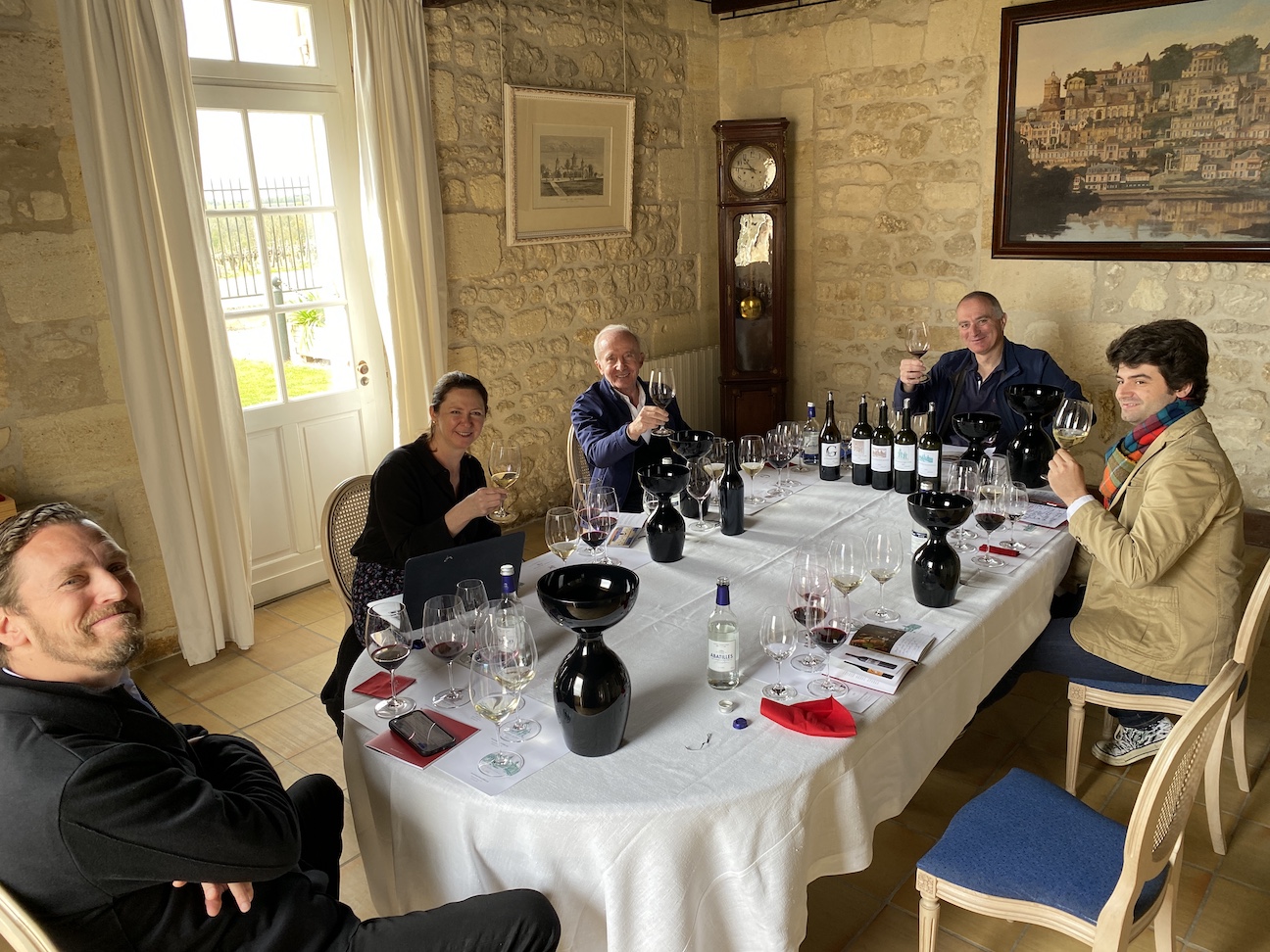
All smiles at Cos: both red and whites a delight in 2021
Château Cos d’Estournel Second Growth* – This blend of 64% Cabernet Sauvignon, 30% Merlot, 4% Cabernet Franc and 2% Petit Verdot transcends 2021 with vivid cool blue fruit, tobacco leaf, spice, artisanal chocolate, pepper and spice and excellent freshness on the finish, backed up by palate density and underlying power. Aging in 55% new oak and clocking in at 12.7% alcohol, it reflects superb lower alcohol balance. Top wine! 95-97
Château Cos Labory Fifth Growth – This blend of 60% Cabernet Sauvignon, 33% Merlot and 7% Petit Verdot comes across a bit Old School, and that is not bad, as the profile is not so different from prior vintages, albeit with an accentuation of tannic edginess, but fruit is ripe and barrel ageing will smoothen the texture. 92-93
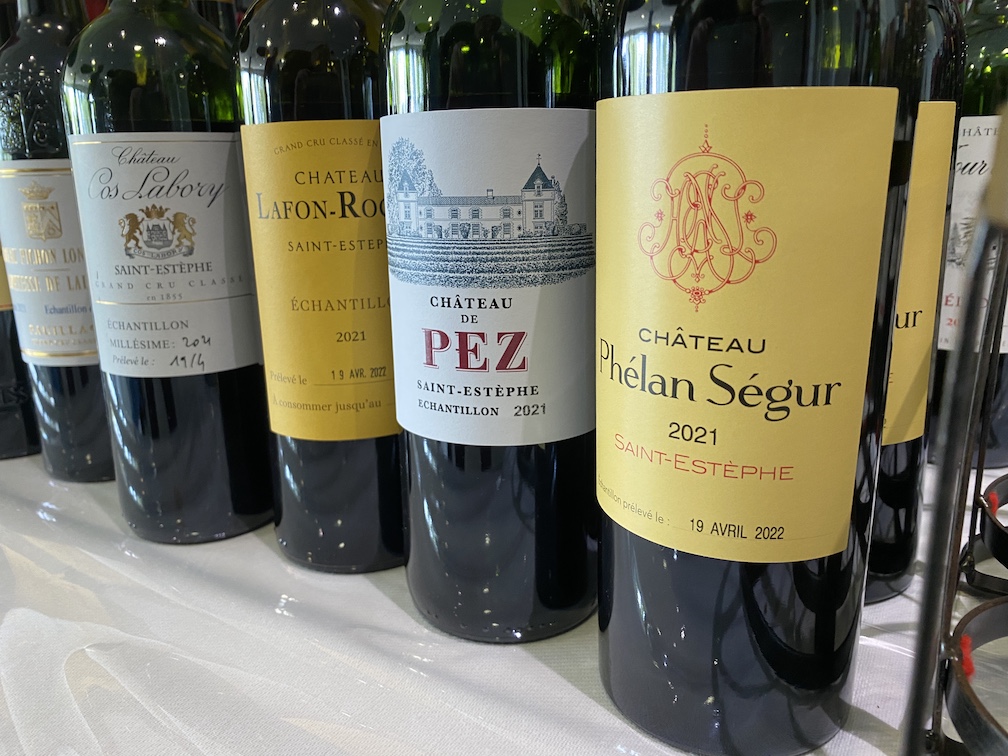
Generally the most cohesive appellation in the Médoc: Saint Estèphe
Château La Haye – After sampling some hard and unfriendly Margaux “cru bourgeois” level wines at the Grand Cercle, this clearly displayed more mid palate concentration, leaving the impression of wine with superior focus, actually vinous, and not “trying” to be so. While not “solar” with bright fruit, at least some supple tannin. 89-91
Château Lafon Rochet Fourth Growth – The blend of 69% Cabernet Sauvignon, 26% Merlot, 4% Petit Verdot and 3% Cabernet Franc comes across a touch austere but not overtly so. I appreciate the mid palate juiciness typical of the wines from Saint Estèphe, so let’s see from bottle, as I only tasted it once. 91-93
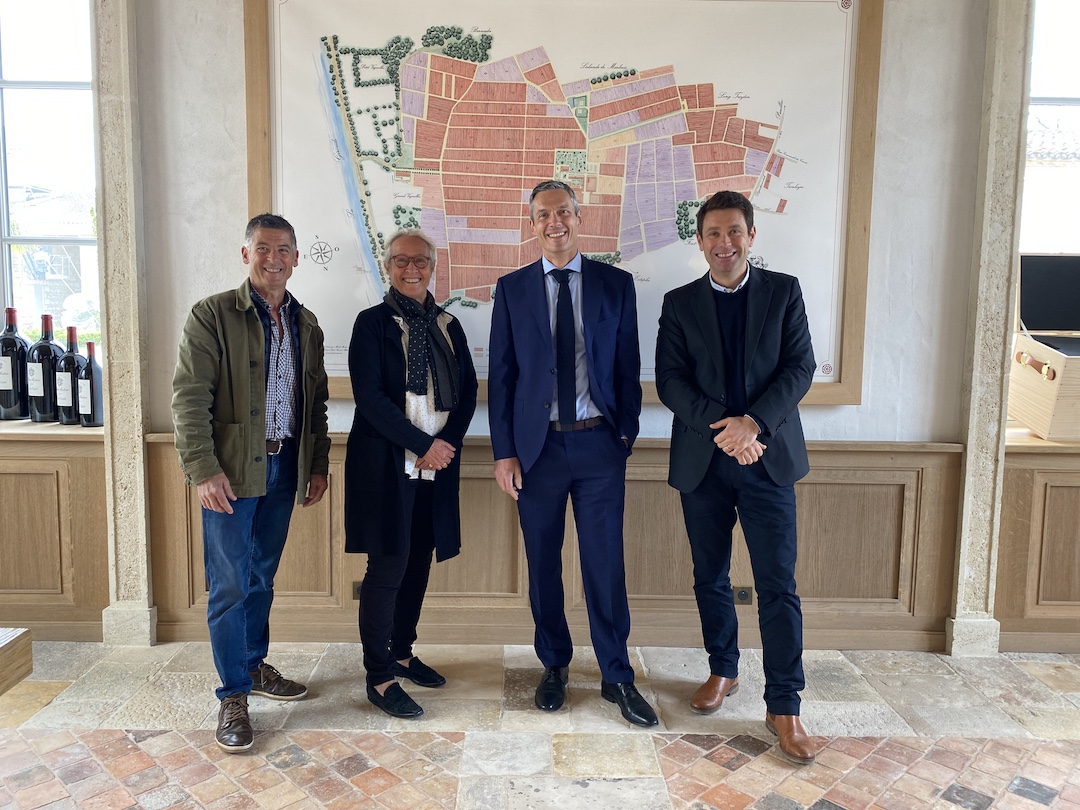
Changes: Pierre Graffeuille, second from right, and formerly with Château Léoville Las Cases, joins the team at Château Montrose in 2022
Château Montrose Second Growth – This blend of 62% Cabernet Sauvignon, 31% Merlot, 6% Cabernet Franc and 1% Petit Verdot impressed me with a fine, focused palate and foreboding tannin but not hard: More evidence of the success of the Saint Estèphe appellation, with tobacco leaf and purity of (fresh) fruit. It just lacks the vigor and density of a vintage like 2020 or 2019, but we are not asking for the moon, either. Nice work! 94-96
Château Ormes de Pez – While tasting at Château Lynch Bages, the white really got me excited but also this estate, the first of the Saint Estèphes that I encountered last month – and I remarked how effortlessly full bodied it was, with mid-palate sap and freshess. Aging in 45% new oak, this blend of 49% Merlot, 40% Cabernet Sauvignon, 6% Cabernet Franc and 5% Petit Verdot gives the impression of wine to clearly benefit from barrel aging. 92-94
Château Petit Bocq – Even better than La Haye, tasted just beforehand at the Grand Cercle, this is one of my favorite cru bourgeois level wines from the appellation. Certainly the palate came across more full bodied the palate than any of the Margaux wines also tasted at the Grand Cercle. And it conveys focus and nuance. 90-92
Château de Pez – This blend of 62% Cabernet Sauvignon, 36% Merlot and two per cent Cabernet Franc reflects the success of the appellation. Cropped at over the appellation limit (57 hectoliters per hectare), the estate saw no frost or mildew menace. With no added sugar, the wine clocks in at 13.2% alcohol with a pH of 3.65. It is spicy with ripe Cabernets and aromatic Merlots. It exudes mid palate tension with juiciness and true “drinkability”. And yet, I can sense the vintage on a “lower register” as compared to, say, 2019. You do get fruit, but with touch of vegetal. Not green pepper or pyrazine, but wet forest and tea leaf as opposed to exuberant fruit. 92-94
Château Phélan Ségur – Rather powerful tannin and ripe fruit pose promise even if toughness perturbs the finish. On the other hand, barrel ageing will soften the palate enough, so that the wine could turn out better. This wine impresses for solidity and concentration that you would have not expected from 2021. 92-93
Category: Blog Tagged: #UGCB, Bordeaux barrel 2021, Crus Classés de Graves, Grand Cercle, Joanne, Maison de Graves, Pomerol Seduction
 Wine Chronicles
Wine Chronicles
Share This